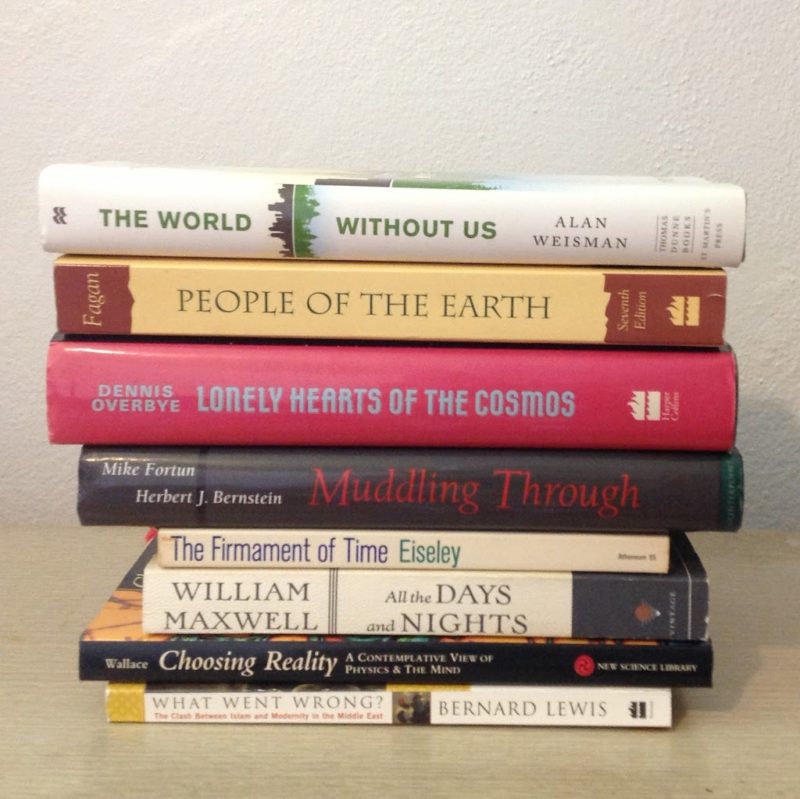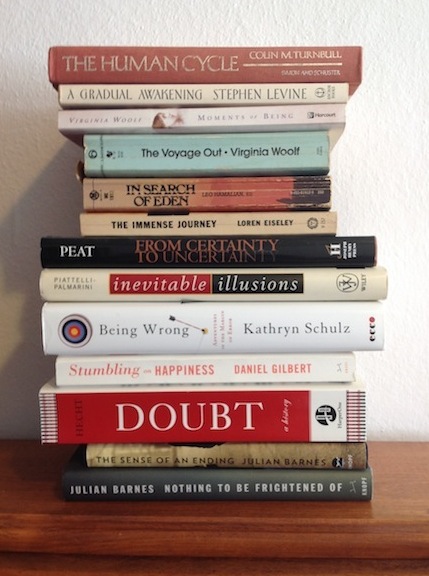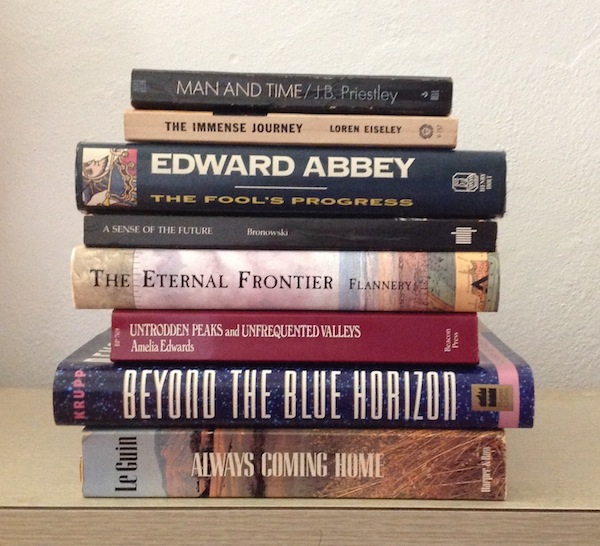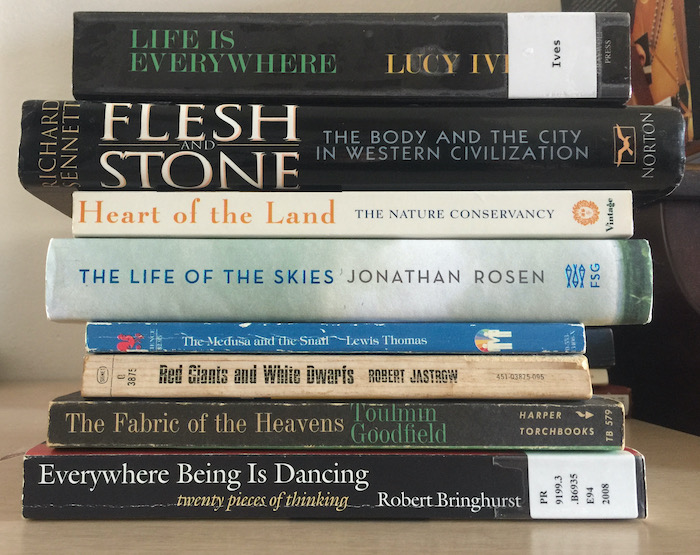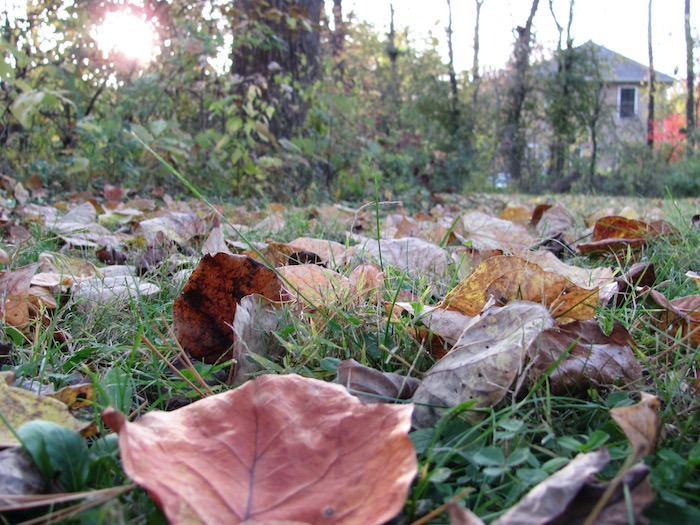In 2011, I visited Paris and blogged about it. This page contains all the posts from that old blog. (Regarding pedestrianism and Paris: In 2018 I sold my car, and in 2019 I traded in my driver’s license for an ID card. Under the leadership of Mayor Anne Hidalgo, Paris has become a much more bicycle-friendly (and thus pedestrian-friendly) city and is on the way to further improvements.
What’s all this, then? (June 1, 2011)
I’m going to be spending two weeks in Paris this month. In preparation, I’ve been reading up on the history of the city, its many splendid buildings and beautiful streets, and the countless writers who have lived there. My own writing has been somewhat sluggish for the past six months or so, and I am hoping to find inspiration there. So my first purpose for this blog is to create a place where I can write some of my notes about the city.
Le flâneur is a wanderer, an urban walker, one who observes the life of a city but maintains a certain detachment. (La flâneuse, of course, is the female of the species.) Some connotations of the word also suggest a curiosity about the city and a desire to experience it fully. This idea appeals to me. In fact, one thing that appeals to me greatly about Paris is that the central part of the city is so walkable; it is the quintessential flâneur habitat. My happiest memories of my childhood involve walking with my mother through Riverside, California. (Too bad we moved to Phoenix when I was 7. The walking just wasn’t the same there.) Over the past 15 years or so, I have been able to adopt a largely (but not entirely) pedestrian lifestyle.
Walking gives me time to notice and enjoy all the quirky little sights and sounds of life in a college town and to become familiar with the ebb and flow of energy, conversation, and motion across campus and downtown. In addition to observing human nature, I see a certain amount of wildlife (birds, chipmunks, squirrels, and the occasional deer, muskrat, or possum; a friend even saw two ducks paddling across a flooded walkway this spring). There is a lot of nature to be found even in the city; when you think about it, the much-maligned weather is nothing but an ever-present manifestation of it. In years of walking, I have come to know my favorite trees, gardens, and yards, and I have my favorite hangouts, indoors and out, for reading, writing, and eating. My second purpose for this blog, then, is to use it as a place to write about urban nature (human and otherwise) and about the pleasures and politics of human-scaled neighborhoods and transportation at human-scaled speeds.
Welcome.
What to read in Paris? (June 3, 2011)
I’ve been thinking a lot about packing for Paris, and in particular what books to bring. I’m loading up my Reader; this is my first trip with an e-reader, and I’m very glad to be able to bring lots of free books that take up very little space. (I’m bringing a lot of Dumas; perhaps I will fall in love with D’Artagnan all over again.) I’ve also got quite a backlog of magazines to read on the plane; the advantage there is that I can shed them as I finish, lightening the load as I go. (Leave some in New York, leave some in Helsinki…I kind of like the idea of leaving a trail of words behind me as I move toward Paris. The trick, I suppose, is to also lay down a trail of my own words in my notebook.)
Most of my time in the city will be spent immersing myself in the sights and sounds, walking down the streets, enjoying the food, trying the wine, and, no doubt, simply marveling and trying not to gawk too obviously. (Not to mention a certain amount of amateurish fumbling with a strange currency and a not-familiar-enough language.) I also picture myself sitting in cafes and green parks with my notebook, packing my impressions and thoughts onto the page for later leisurely reminiscing and reworking. But surely there will be some time to sit and read! I am going to be staying near the Place des Vosges; perhaps my paperback Hunchback of Notre Dame would be appropriate for reading in the shadow of Victor Hugo’s former residence. Would it be too touristy to sit and read Edmund White’s The Flâneur? Or Hemingway’s The Moveable Feast? I hope not. Let me know if you have any recommendations for what to take, either in e-form or in good old traditional dead-tree format.
Old places (June 5, 2011)
One of the things I am really looking forward to about Paris is all of its old buildings. I grew up in Phoenix, where almost everything seemed to have been built since World War II. When I was a child, if a building was 50 years old, it was a really old building. (The Arizona desert has thousands of years of history, of course, but the streets of the city I walked as a child, and the buildings I saw, seemed to have sprung up only yesterday, and indeed many of them had.) As I moved east in the U.S., I saw older and older places, culminating in a visit to Jamestown, Virginia. It’s a logical next step to keep going east to Europe, and I’m glad I’ve finally got the opportunity to do that.
One thing that old cities have is a lot of layers of context and history. I recently read a short history of Paris, and particularly of its buildings and monuments. One story that particularly caught my eye was that of a statue of King Henri IV on Pont Neuf, the new bridge, which is now supposedly the oldest bridge in the city (in terms of physical structures anyway; I think other bridges may have been located at one spot under one name for longer, but the originals of those bridges are long gone). King Henri was the king who renounced Protestantism in favor of Catholicism and was supposed to have claimed that Paris was well worth a Mass; he was humane enough to enact the Edict of Nantes, which gave Huguenots the freedom to practice their religion without fear of persecution.
When he died, his widow, Marie de Médici, commissioned a statue of him on a horse for the Pont Neuf, which actually was new at the time. During the Revolution, the statue was melted down for cannon. (The French call Henri IV “le bon roi Henri,” but perhaps even a bon roi did not seem all that bon at the time.) When the monarchy was restored, a statue of Napoleon (according to some sources) or Louis Desaix, a nobleman who escaped death during the Revolution and wound up fighting for the Republic (according to Wikipedia) was melted down to replace the statue of Henri IV. The book I read claimed that the fellow who made the new statue of Henri IV secretly sympathized with Napoleon and placed a small bronze of Napoleon and “other seditious artifacts” in the hollow belly of the horse. Online sources list several much more pedestrian documents that are supposedly inside the horse (basically the equivalent of the plaque on modern buildings that lists the donors and the architect). Either way, I am looking forward to seeing this statue, wondering what’s inside, and thinking of both the religious upheavals of the 16th and early 17th centuries, which Henri IV helped end, and the Revolution and its aftermath.
(My source for the story of the statue is Paris From the Ground Up by James H. S. McGregor, Cambridge, Mass.: Belknap Press, 2009.)
Helsinki (June 8, 2011)
I’m in the Helsinki airport waiting to board my flight to Paris. (All of the links on the Blogger page showed up in Finnish; OK, I thought, I will go to my profile and see if there is some setting that I can change so I always use English. Of course, the profile setting links are all in Finnish too. Hmm. I figured out how to post, anyway.) The flight from JFK to Helsinki was rough in spots but otherwise uneventful. The canned safety spiel at the beginning of the flight said, “If you plan to sleep, please remain seated.” Well, OK, I suppose I can do that. I don’t think it was ever really dark outside during the entire overnight flight; between that and the time change, it was all very agreeably peculiar.
Next stop: Paris!
Je suis à Paris! (June 8, 2011)
Arrived mid-afternoon, jet-lagged and wound up. It took about 24 hours from the time I left Bloomington Tuesday morning until I arrived at the Charles de Gaulle airport this afternoon (local time in both cases). The neighborhood where I’m staying is fantastic. In just a relatively short walk (five or six blocks one way) to get acquainted with the area, I counted about half a dozen wine shops, four or five chocolate shops, several markets full of fresh produce, and a Monoprix (one-stop shopping). Oh, and several bookstores. You can smell the cheese shops from outside as you walk by.
The apartment came with some food:
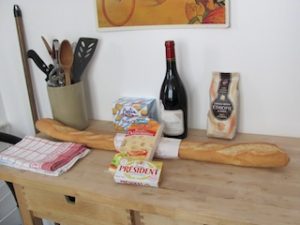
That’s a nice bottle of Côtes du Rhône:

After the walk, I had bread, cheese, and wine. A little more wine and I’m going to finally get a good night’s sleep.
First day (June 9, 2011)
Quelle day! My first full day in Paris has been absolutely wonderful (and very long!). Just a few high points below:
- Visited my first Parisian church, the Eglise Saint-Merri, and the nearby Saint-Jacques Tower, all that’s left of a church that used to mark a starting point on the road to Santiago de Compostela. Inside the tower is a statue of Blaise Pascal, placed there to commemorate some experiments on atmospheric pressure that he conducted, possibly at the tower. We also visited the Church of Saint Gervase and Saint Protase, where several generations of Couperins played the organ. At one point I looked directly up at the ceiling and found a stone angel, arms spread wide, looking benignly straight down at me. I reported this to my friend Jay, who told me that the angel was helping support the organ over my head. “I’m glad,” I said.
- On the way to the river, we visited the Hotel de Ville, surely the most magnificent City Hall in the world. It’s an astonishing building; the facade is full of niches containing statues of historic figures, including a number of scientists. I was pleased to see that the main entrance was flanked by statues of the scientist Lavoisier and the skeptic and writer Voltaire. One of the most magical moments of the day, however, was catching sight of the two towers of Notre Dame just across the river. I have been reading about this place since I was 12, and now here I was standing in sight of it. In the photo below, the Hotel de Ville is on the left, and the towers of Notre Dame are further away on the right.
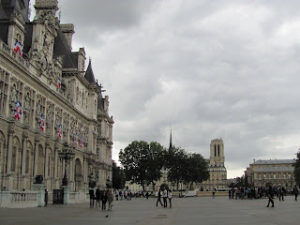
- We crossed the river to the island and had a piece of apricot flan from one of the many, many patisseries and other eating places. I fed a crumb to a bird who hopped up on the table and cocked his head at me inquiringly. I think he really was begging for food, because when I moved my hand toward him to drop the crumb in front of him, he came forward to meet me rather than flying away. (This city is full of birds! Lots of pigeons, some crows, LBBs [little brown birds] like the one that begged for crumbs, and somewhat larger brown birds [SLBBs?] that we saw squabbling over some food in a park.) We got more views of the church from the outside; even by the end of the day I still got a little teary-eyed when we passed it walking home. (We’re going to visit the inside and hear an organ concert there on Sunday.) We also visited the Marche aux Fleurs on the Ile de la Cite. I knew I couldn’t bring back any of the plants with me, but I did look at the seeds. I didn’t buy anything, but I noticed that someone had seeds for les choux d’ornement (ornamental cabbage; “très originale!” the seed packet said). The flowers in the market were gorgeous.

- A boat tour gave us a chance to see some of the highlights along the river, including several notable bridges, the Louvre, and the Eiffel Tower (which is on the agenda for tomorrow).
- Dinner was a leisurely (about three hours) and excellent meal with a group of about a dozen people who are all renting apartments through the same company. I had my first taste of kir (white wine with black currant liqueur; excellent to drink and also a lovely deep pink color, very elegant in a flute). It was a pleasant evening; my only complaint, and it is a mild one, is that the music in the restaurant was a loop of various popular songs, including “Itsy Bitsy Teeny Weeny Yellow Polka-Dot Bikini” in French. The song (in English, malheureusement) is still running through my head. Dinner was followed by a stroll home through the 10 p.m. dusk.
It is 704 steps from the ground floor to the second floor of the Eiffel Tower, and I am going to climb them tomorrow afternoon, so it is time to get some sleep.
Les Invalides and environs (June 10, 2011)
Today was one of the more touristy days on the schedule. It also involved quite a lot of walking, which, while quite enjoyable, provides an excellent rationale to finish off that bottle of wine in the apartment. (I am sipping as I type. Caveat lector.)
The morning started with a walk down the river to the Pont Alexandre III, the most ornately exuberant bridge I have ever seen. Bronze gilt statues sit on top of four high pillars, and the bridge is adorned with nymphs, lions, and other wildlife, as well as ornamented with many gilt embellishments. Yesterday on the boat tour, I enjoyed seeing the different characters of some of the bridges, and this one is by far the most easily recognized from a distance, even from atop the Eiffel Tower.
We crossed this bridge when we came to it, and it took us to Les Invalides. This group of buildings was established in the 17th century by Louis XIV as a hospital and retirement home for veterans. A history of Paris that I read before the trip mentioned that health care until then had been supplied by members of various religious orders or by lay people working with the church, and this was a very early effort at state-supplied health care, a topic still of interest today. Today the buildings contain museums and monuments having to do with France’s military history. We chose not to go inside any of the buildings, but there is a gorgeous chapel (the Église du Dôme) that I wish there had been time for; it contains Napoleon’s tomb, which is not that big a deal to me, but from the outside it was quite a lovely building, and I would have liked to have seen the inside. (Next trip…) The square enclosed by the buildings of Les Invalides contained various cannons with plaques describing them; I was surprised and somehow oddly touched to find that each one had a name (L’intrepide, Hercule, etc.).
For lunch, I got to try croque monsieur in a very pleasant restaurant in Rue Cler, a nice little street filled with food and shops. I was enchanted by the name; I had heard that it was a ham and toasted cheese sandwich, but that description doesn’t quite do it justice. The ham goes on a single slice of bread, and the cheese (my best guess is something resembling mozzarella) goes on top, and then the whole thing apparently goes under the broiler. Nom nom.
Eiffel Tower and environs (June 10, 2011)
The Eiffel Tower is located at the end of the Champs de Mars, a lovely set of gardens and lawns stretching from the front of the École Militaire. As you enter the fields dedicated to the god of war, you pass by a monument to peace, which is an interesting message.
I did not in fact climb the steps to the second level of the Eiffel Tower because the pillar we went up offered only elevator access. We found this out after waiting in line 15 minutes (this is a relatively short wait, by the way; we bought tickets before leaving the U.S., and without tickets it can take much longer), so we gave in with good grace and took the elevator. We did walk down from the second level, but that’s a much less strenuous, if somewhat giddy, undertaking. A ticket gets you up to three different levels: two nearer the ground, and then the top of the tower. The signage at all three levels is poor, and it is all too easy to inadvertently get caught up in a dense polyglot human gyre slowly circling the outer edge of the tower awaiting an elevator up or down. However, each level has two stages, one of which is much less crowded; once you can find your way to it, the viewing is far more leisurely and less pressured at this second level. I suppose I should be happy the signage doesn’t direct more people to these levels? On the other hand, an even distribution of human bodies might be more advantageous.
At any rate, being up in the tower gives a superb view of the city and its more notable structures and landscapes. This trip up the tower and the boat tour yesterday provided a good orientation to the city. Sacré Coeur is clearly visible from up there (on a hill to the northeast, one of the highest points in Paris), and various other cathedrals and monuments are also visible. Despite the wind, rain, and cold, it was a great deal of fun to start matching images to my mental map.
The Trocadero Gardens and the Palais de Chaillot are on the other side of the Seine from the tower. The Fountain of Warsaw (water cannons shooting water periodically out into a long rectangular pool) is a key feature of the gardens, and various sculptures are placed near the fountain and the palace. (This city seems to have as many outdoor sculptures as it does pigeons, and that’s saying a lot.) The palace consists of two beautifully curved symmetrical buildings (especially lovely from the tower). It was the site at which the United Nations General Assembly adopted the Declaration of the Rights of Man late in 1948, and the esplanade des droits de l’homme contains eight gilded figures representing various human rights. I was most moved by a stone set into the pavement before the esplanade that described the importance of freedom of expression and was dedicated to journalists who lost their lives in the line of duty. To paraphrase the Moody Blues, Keep on thinking and writing free.
Getting around central Paris (June 10, 2011)
Yesterday I learned why Paris has so many churches: So you can pray before you cross the street. Some of the crosswalks have no traffic lights for pedestrians, and you have to be careful crossing those. Coming home this evening across the Place de la Concorde at rush hour required a great deal of alertness, and in general, you can’t daydream as you walk when you come to a crossing. The traffic does move with alacrity, and you must as well. However, you have to keep your wits about you when you cross the streets in Bloomington, too; that’s just a general feature of being a fragile biped sharing the streets with cars.
Overall, I would say that the parts of Paris I have seen so far are very pedestrian-friendly. For one thing, I have never had to walk in the street because there was no sidewalk. Every street has a sidewalk (which is more than I can say for my neighborhood back home), and most of the bridges across the river that I have seen so far have ample room for pedestrians. The sidewalks are often quite generous, with sand or gravel shoulders of their own for getting around slower-moving foot traffic. Many crosswalks have not only walk-don’t walk signals but also warnings to pedestrians about unusual traffic patterns to beware of. This morning’s walk along the river followed alongside heavy and sometimes complexly patterned automobile traffic, but as long as I paid attention, it was a much more tranquil experience than navigating near some of the busier streets in Bloomington. (Well, having the river there didn’t hurt. But still…)
I have seen a decent number of bicyclists here, and I’ve noted a fair number of bicycle lanes (but I haven’t been paying particular attention to those). Only one of the bicyclists I’ve seen so far was wearing a helmet. The motorcyclists all wear helmets, which is good because they tend to drive with a great deal of verve and panache, i.e., like maniacs (especially on the peripheral highway, which we saw only on the ride from the airport).
Art, churches, and a great big park (mostly art) (June 11, 2011)
Today I visited two museum, the Musée d’Orsay and the Musée Rodin. The Musée d’Orsay is in a building that started life as a lovely Beaux Arts train station. The building was converted (evidently with a great deal of care) to a museum in the 1980s. The center of the museum is occupied by a large open sculpture gallery with the arched ceiling of the old train station rising above; it is a very impressive space. The museum is known for its Impressionist collection; going from painting to painting was a continual feast. I was, predictably, moved to tears by the sight of some of Monet’s and Renoir’s better-known paintings that I had seen only in books and now saw on canvas at full size. I was also haunted by the works of Van Gogh that I saw, including some of the last things he painted. I really appreciated that fact that I also saw some Renoir landscapes (not his most typical subject) and some paintings by Monet that I wouldn’t have guessed were his (because of either the subject matter or the style). So it was a nice balance of meeting old friends face to face and finding new aspects of some of my favorite painters’ work.
At the Musée Rodin, today I visited only the garden, which is full of roses and sculptures. The museum is located in the Hôtel Biron, a private mansion built in the 18th century; Rodin later had his studio here. The outside of the building and the grounds are lovely.
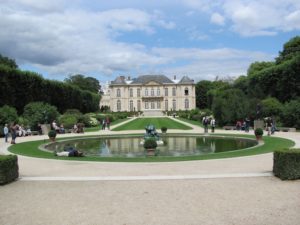
Note the sculpture in the pool. (Yes, that is someone’s backside you are seeing.) It is a piece from the Gates of Hell (which are standing near the rose garden) depicting the fate of one Ugolino della Gherardesca, a real-life Italian nobleman who came to a bad end. He and his sons died of starvation, and their demise was described in Dante’s Inferno, which inspired several artists. Here is a better view of Rodin’s interpretation, taken from the side.
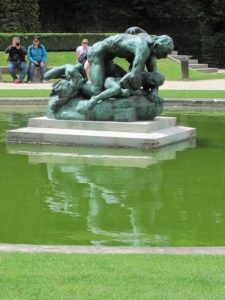
Those of you in Bloomington may be familiar with a statue in the Indiana Memorial Union near the entrance to Whittenberger Hall. That statue also depicts Ugolino and his sons; it’s the plaster original of a statue by Jean-Baptiste Carpeaux that was sent to Indiana by the citizens of France in 1948 in gratitude for help rendered after World War II. (The plaster original was later cast in bronze; I have read online that the bronze is in the Petit Palais, the Louvre, and the Metropolitan Museum of Art in New York City. The Met does seem to actually list it among its holdings.)
I also visited three beautiful churches, St. Clotilde (where Cesar Franck was an organist for many years), St. Germain des Prés (one of the oldest, if not the oldest, in Paris), and St. Sulpice (huge, many beautiful chapels, and some paintings by Delacroix). I also basked in the sunlight in the Luxembourg Gardens while people dozed, strolled, chatted, and read all around me, and walked through some interesting parts of St. Germain des Prés, including the Place Jean-Paul Sartre Simone de Beauvoir and the area around the famous cafes where Hemingway and other writers used to hang out. It is a happening spot on a Saturday afternoon in June. I’m planning to spend more time in that area next week.
Parisien (June 12, 2011)
Seen on a motorcycle on a street near my apartment:
![Bumper sticker reading "I [heart] rien, i'm parisien" (where a heart symbol appears after the word "I."](https://maryhrovat.com/wp-content/uploads/2024/01/bumper-sticker-300x283.jpeg)
The Islands (June 12, 2011)
Today was all about two islands in the Seine, the Île de la Cité and the Île Saint-Louis. Notre Dame was the big story of the day, although I also heard a lovely concert of chamber music in the Sainte-Chapelle, a gorgeous place whose stained glass glowed with beautiful blues and reds even on a cloudy evening.
I started the morning by climbing the towers of Notre Dame. They route climbers partway up the north tower, across to the south tower, and then up to the top of that. The route up is a spiral stone staircase, with worn spots on the stairs where thousands of people have walked before you. This gargoyle (at the halfway point, partway up the north tower) appears to be bored, but then he’s been there for hundreds of years. I was thrilled.

I walked across the area connecting the two towers, which is above the slender pillars over the rose window. The views from there and from the top of the south tower (on the right) were fantastic.
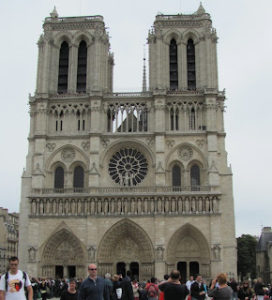
The interior, which I saw in the afternoon, was gorgeous, but it’s hard to do it justice in photographs, considering that you’ve probably already seen it a bezillion times. I will note that one thing I love about this building is that it offers so many different views from different angles. This is just one example.
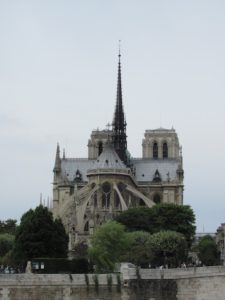
That’s pretty close to the view I saw just before I crossed the bridge to the Île Saint-Louis after climbing the towers. The bridge was closed to cars, and there was music.
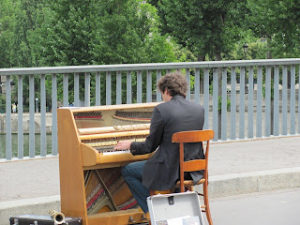
How they got that piano there, I do not know, but there was also a clarinet and a double bass, and I listened to the music while sitting at a sidewalk café eating a cheese platter and a salade Auvergnate. Tough work, indeed, but someone has to do it. After lunch, I had ice cream (one scoop of a rich dark chocolate, one scoop of a pleasantly tart raspberry) from Berthillon, which I had heard about before I came. Their fame is well earned.
After visiting the inside of the cathedral, I walked down to the Square du Vert Galant, one of the more beautiful little parks I’ve seen in this city (and that’s saying something). Then back to the cathedral for a recital of organ music.
This is a bit text-skimpy and picture-heavy, but I need to get some sleep. Tomorrow I’m going to see the Louvre, According to an old Lonely Planet book in the apartment, it’s one of the most actively avoided museums in the world because it is so daunting, but I’m sure it will be crowded, and I want to get there early.
Mouchoirs (June 13, 2011)
On the box of facial tissues: 110 mouchoirs, pour les très gros chagrins. (Never mind colds or allergies; these are for when you’re weeping your heart out.)
Art, history, and more art (June 13, 2011)
So the Louvre is indeed crammed with tourists, but if you avoid the obvious draws, or pay your respects to them and move on, there are some surprisingly spacious areas where you can walk slowly without accidentally wandering into the field of view of someone’s camera (at least not too often). Getting there early and having a museum pass purchased ahead of time were also helpful.
Of the big three (the Venus de Milo, the Winged Victory of Samothrace, and the Mona Lisa), I had my heart set on seeing at least the first two, and I did. I happened on the Venus at a relatively quiet time and had the chance to walk slowly around and see how beautiful she is from all sides. One of my favorite memories is of a monk in brownish-yellow robes (I guessed he was a Buddhist) taking a picture of the Venus de Milo: multiculturalism at its finest.
Some of the things I enjoyed the most were not the ones everyone goes to see. When we came to the room that held the Mona Lisa, we decided it was not worth fighting the crowds to get close. (We wondered later how Leonardo had felt about that painting and if it was one of his favorites.) However, on the opposite wall of the same room but getting far less attention is a lovely huge canvas by Veronese, The Wedding Feast at Cana; it depicts the wedding (at which Christ turned water into wine) as a huge Venetian banquet with many sumptuously dressed people in attendance (with Jesus sitting in the middle looking somewhat aloof). It was one of those where everywhere you look, you see some new detail to relish, so it was a pleasure to enjoy that in relative peace.
I saw many other noteworthy or lovely paintings, including the biggest one in the museum, The Coronation of Napoleon, by Jacques-Louis David. It’s another crowd scene, this one of even more sumptuously dressed people attending the coronation of Napoleon as emperor. (I believe this is probably about the point at which Beethoven became disgusted with Napoleon, or at least is emblematic of why he did.)
One of my favorite parts of the visit was a trip down to the basement (the −1 floor, or entresol level) of the Sully Wing. I had read that you could walk along the former moat and view the foundations of the fortress built by Philippe Auguste in 1190. This was a fantastic sight, at least for a history nut. I love anything that lets me feel that I am in the presence of the past, and the base of the huge round stone tower did that splendidly. After this, I moved on to something that reminded me of just how recent the 12th century was, relatively speaking: the basalt stele on which is written in cuneiform the Law Code of Hammurabi. This is one of the earliest and certainly the most important compilation of legal code in the ancient Near East, and it was written in the 18th century B.C.E. Years ago in junior college, back when I was 16, I read about it in Western Civilization 101, and today I got to see it.
Yesterday while I was waiting in line at Notre Dame, I remember looking up at the tower and at all the gargoyles (no two alike, as far as I could see) that stuck out from the roof line, and feeling lifted out of my usual perspective. You live your life among people and their buildings and doings and you just accept that people are like this, they build things and do all kinds of strange things. But if you stop to think about the larger picture and look at humans as animals among others on this planet, sometimes you realize that as animals, we exhibit some very peculiar and interesting behaviors: Why would an animal do that? Why would an animal invest such huge amounts of resources in building this incredibly complex and beautiful thing? (I heard philosopher Daniel Dennett make a similar point once when he was arguing for the scientific study of religious behavior: if we saw any other animal doing the things we do in the name of religion, like gathering en masse at the Ganges at certain times of the year, we’d certainly want to investigate what that was all about.) I felt something similar at the Hammurabi stele today, only it was more like seeing a glimpse of the very beginning of how this unusual and fascinating animal tried to learn to live in large groups.
After all this history came lunch. I spent some pleasant time in the Tuilieries Gardens afterward and then an hour or two in the Musée de l’Orangerie, which features Impressionist and post-Impressionist paintings. I saw a lovely long room full of paintings by Renoir, but the high point of this museum was two long oval-shaped rooms containing paintings by Monet, one with paintings of of water-lilies and one with paintings of willows and water. He donated these paintings in this setting to the people of Paris so they would have a peaceful place to relax. They were among some of the most beautiful of Monet’s paintings that I’ve ever seen, with subtle shimmering blues and greens. Maybe the sheer size of them helps; you can lose yourself in them. It was a fitting end to the day’s museum visits.
Dinner (June 13, 2011)
Man does not live by art alone:
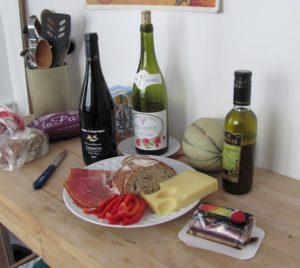
On the plate: Bayonne ham, bread, Emmentaler cheese, sweet red peppers; on the table: wine (deux), melon, vinaigrette, small cake from one of the neighborhood patisseries.
You know you’re in Paris when… (June 13, 2011)
…the instructions for the washing machine say “Half a wine glass of powder or one-third wine glass of liquid should be sufficient for a full load.” (This is in a booklet of helpful information for renters of the apartment.)
The sacred (June 14, 2011)
Today was my introduction to the Paris Métro (as well as an intercity train between Paris and Chartres and the RER, which offers express trains between central Paris and the Paris suburbs). I liked the Métro, and I love being in a city that is connected by train to so many other places. One thing I learned about the Métro and the train station during rush hour is not to stop moving when walking between trains. If you have to stop to orient yourself, pull over to the side, just like you would in a car. You’re one particle moving among a stream of high-velocity particles who know their way around, and they will keep moving even if you stop. I don’t generally enjoy crowds, but I do like watching experts maneuvering their way through a subway or train station. The train station was a great place for people-watching.
The trip today started with a visit to Chartres, about an hour outside of Paris. It is a smallish town, pretty in its own right (at least the parts I saw). The Eure River runs picturesquely through town, and there are some very old half-timbered houses.
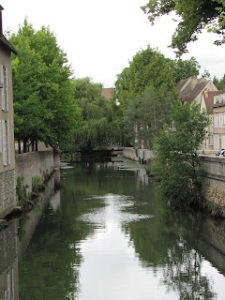
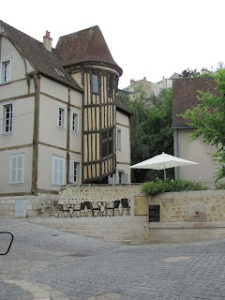
Chartres is also home to a large and beautiful cathedral. The cathedral is certainly the biggest thing in town; it makes navigation relatively easy because the towers are a useful reference point.
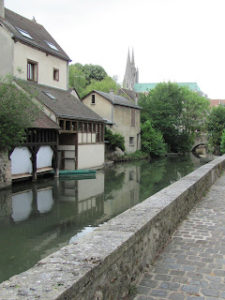
The church is home to a relic, a length of silk that is supposedly the garment that the virgin Mary was wearing when she gave birth to Jesus. Several churches dedicated to Mary have stood on this spot, and after a fire in the late 12th century, the relic was believed to be lost but then was found intact after all. This was taken as a miracle and motivated people to rebuild the church better than ever as a center of pilgrimage. (People still come on pilgrimage to see this relic, which surprised me.) It was constructed within a remarkably short period of time (the fire was in 1194, and much of the new church was completed by around 1250), which gives it a unity of style that is not always a feature of the big cathedrals of the time. Much of the stained glass is intact, and the stonework is undergoing renovation. The main entrance was obscured by scaffolding; this is the south porch (I believe the stone on the upper parts has already been cleaned).

We investigated the church on our own and also went on a tour led by Malcolm Miller, an Englishman who came to visit 54 years ago, fell in love with the cathedral, and has stayed on and studied it ever since. He is a witty and highly knowledgeable guide; if you’re ever in Chartres, I recommend one of his tours (daily Monday–Saturday at noon and 2:45). He described the cathedral as a book, one that told a story in stained glass and statues, and one that the illiterate people at the time it was built would have known how to read. He sees the building as encapsulating the complex Christian worldview of the time; he gave us an idea of how the stories told in the stained glass and in the statues are related to each other and are interwoven to create the larger story of loss and redemption. I don’t believe in this story myself, but I am fascinated by the idea of using an entire building as an information system to store and transmit the knowledge considered essential in a particular time and place.
The older I get, the more I realize the degree to which effective communication depends on a shared reference system, and the degree to which subtle and unexpected differences in reference systems can trip people up. Some days I’m amazed that any human brain can ever convey any meaningful idea to another human brain with any degree of precision, even for two brains of the same generation, country, and language. I guess that’s one reason history is so interesting to me; the possibility of getting into the mindset of people in another place and time, much less one so long ago and one that has had such an influence on our world, is really exciting, even if the insight is bound to be only partial. (And, of course, the sheer scale of the thing and the beauty of the old stone and the stained glass made me go “Oooooo!”)
The profane (June 14, 2011)
This afternoon, we spent a few hours at Versailles, the profane end of the trip (profane as in “not sacred” or “secular”). The main thing we were interested in was the gardens, although I really wanted to see the Hall of Mirrors in the palace. To see anything in the palace, you must travel the whole tourist route through the building, with people packed shank to flank and stopping over and over again to take photographs. I took very few in the Louvre and none inside the palace at Versailles, figuring that most of what was there had been photographed a million times, often by professionals who could do a far better job of it than I could. I get distracted by the act of photography sometimes and forget to enjoy what is right in front of me. After a while I got fairly irritated at having to make my way through people who were stopping not to look at what they were seeing or admire it or think quietly about it but to take photos of the same obvious things that everyone else was photographing and that I’m sure are featured in the books you can buy in the gift shop. (The worst is the people stepping back to try and capture family and friends against whatever fabulous backdrop we were all supposed to be enjoying, thus causing more congestion–and for what? to prove that they had been there? in every single room?).
Yeah, I know, what do you expect if you want to see anything inside the palace? Griping aside, the palace is a marvel. The chapel was even more impressive than the Hall of Mirrors in terms of beauty, harmony, and scale, but I still felt a bit of a thrill in the Hall of Mirrors, largely because of the historic events that have occurred there (most notably, the Treaty of Versailles was signed there in 1919, ending World War I). Al Stewart has an excellent song called “League of Notions” about the establishment of the League of Nations after the war; it begins “I’m here sitting in the wreck of Europe with a map of Europe spread out in a hall in Versailles…”.
The gardens were delightful. The scale of Versailles is truly astonishing, and the highly groomed flower beds and trees exemplify the French style of formal gardens in which nature is controlled and rendered harmonious. I tend to prefer a more natural style, but still, this was quite an impressive example of the formal approach.
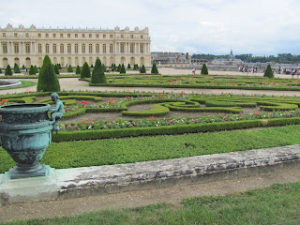
This view is from the Apollo fountain, partway down the long, long lawn from the palace:
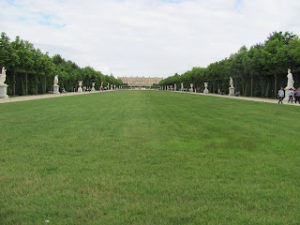
Rick Steves, whose 2011 guidebook to Paris has been invaluable, describes this view thus:
Looking back at the palace from here, realize that the distance you just walked is only a fraction of this vast complex of buildings, gardens, and waterways. Be glad you don’t have to mow the lawn.
The grounds include a Grand Canal (not the Grand Canal, obviously) and some faux ancient ruins (built because the grounds did not boast any real ancient ruins). These things reminded me a bit of Las Vegas, which happily plunders images of landmarks from around the world to create its own little world. Life must have been pretty good for the privileged few who lived in the Sun King’s special world, although I wonder what he would think of all the lesser folk like me going through his palace today. I also wonder if he would have done anything differently if he had known what was coming down the road for his descendants at the end of the 18th century. It was impossible for me to view all this opulence without remembering a quote from Will Durant: “We conclude that the concentration of wealth is natural and inevitable and is periodically alleviated by violent or peaceable partial redistribution. In this view economic history is the slow heartbeat of the social organism, a vast systole and diastole of concentrating wealth and compulsive redistribution.”
Surprising things about Paris (June 15, 2011)
Things that surprised me about Paris:
- There are far more pigeons and other birds than I expected. Even yesterday inside the train station, Gare Montparnasse, I was amused to see a pigeon waddling busily along.
- There is graffiti everywhere, even at the tops of buildings where it’s hard to see how it got there.
- The Eiffel Tower is brown. I guess I had been expecting a steely gray.
- People eat outside even in chilly weather, and cafes and restaurants often have some kind of heater mounted at the top of a pole to make it comfortable outside.
- When I was walking through my neighborhood Saturday or Sunday morning, I was surprised at how intimate a place it seemed; I kept hearing the clatter of plates from open windows and sidewalk tables, which made it seem like I was walking through a huge dining room.
- For an urban environment, the parts of Paris I’ve walked through seem fairly green. I knew from the map that there are parks and grassy squares all over the place (and I really enjoy that), but it wasn’t until after I got here that I could see all the flower boxes and roof-top gardens.
- This last one is not exactly a surprise, but it seems worth mentioning. Until I went to Versailles yesterday, I have seen no big parking lots or garages. There are cars, certainly, but people seem to park them in closed-off courtyards and underground parking garages. You may not even be aware of parking in an area until you see a car emerging from someplace unexpected.
Le Marais (June 15, 2011)
Today was a low-key relaxed day. My friend Jay is at his conference for the next couple of days, and I’m taking a more leisurely pace on my own. I poked around in the neighborhood I’m staying in. The day included a good bit of time spent sitting in the sunshine in one beautiful park or another, writing and people-watching.
This neighborhood, the Marais, is named for the marsh that used to be here. Now it’s full of restaurants, museums, and beautiful old houses. Today I visited the Maison Victor Hugo museum, which is right on the Place des Vosges in an apartment that Hugo lived in for a while with his wife and children. (Speaking of well-known writers in the neighborhood, writer Marie de Rabutin-Chantal, marquise de Sévigné—famous for the letters she wrote—was born near where I am staying.) I also visited the Musée Cognacq-Jay, a 16th-century building containing treasures of 18th-century art gathered by the couple that founded the La Samaritaine department store chain. It was a real treat, full of beautiful paintings, statues, and furniture. I was greatly taken with the fine marquetry on the writing tables and desks.

Both museums were uncrowded, and I really appreciated the luxury of taking my time to appreciate the lovely and/or interesting things on display. I’d go nuts in a place decorated entirely in 18th-century French style, but I do enjoy seeing good examples of the style from time to time.
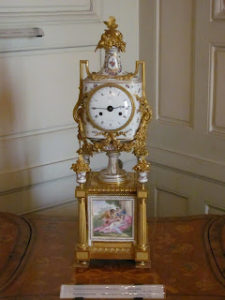
I ate lunch in the Square du Temple, one of the more beautiful squares I’ve seen in Paris (which is saying lot). The land here used to belong to the Knights Templar, who had a palace and garden on or near the site of the present square. I had quiche épinard et chèvre (quiche with spinach and goat cheese) from a nearby bakery while watching people talking, reading, eating lunch, wheeling babies in strollers, and playing ping pong. The backdrop to all this activity was quite impressive.
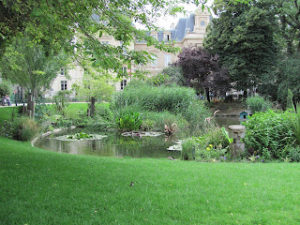
Evidently people are not meant to lounge about on the grass around the pond, although the sign looks almost like it forbids sit-ups.
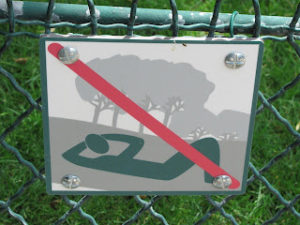
Other grassy areas were open for people to eat picnic lunches on or for kids to run on. After lunch I walked around this part of the neighborhood. I went into a chocolate shop and bought an escargot noir (dark chocolate snail filled with something luscious) to eat as I roamed.
I came back to the apartment in the middle of the day and, luxury of luxuries, took a short nap. Fortified by my brief rest, I wandered around a bit closer to the river. I took a look at some remnants of the old wall built by Philip Augustus very early in the 13th century: two towers and the wall between them, now facing basketball courts. The wall appears to be incorporated into the current buildings. I finally found some old half-timbered houses that are among the oldest buildings in Paris; I’d read about them before coming here but hadn’t been down the street where they are until today.
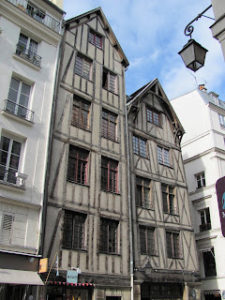
Note that the stories are different heights.
After exploring the food at the Monoprix a bit more thoroughly (I found that they sell a particular kind of cheese, evidently an Emmentaler, specifically for croque monsieur), I spent an hour or so at twilight in the Place des Vosges near one of the fountains, among people sitting quietly reading or talking or eating their dinners. I love this place.
Books, sculpture, music (June 16, 2011)
Today was another laid-back kind of day. I love the Metro! It gets me where I’m going quickly so I have time to roam to my heart’s content once I’m there. Today I visited another church, St. Germain l’Auxerrois, and a bookstore, Librairie Galignani. Before I came here, one of the things I wanted to experience was to stand in a bookstore surrounded by many, many books in a language I do not speak very well, and that’s what I had on this bookstore visit. The store does contain some books in English, but most of them are French. It made me feel that the world is a very rich place, full of untapped possibilities and doors that are just barely ajar and ready to open.
The exchange rate being what it is, I did not buy nearly as many books as I wanted to; it will be cheaper to find some of them on Amazon back home. In fact, I bought just one: Hemingway’s memoir of his life as a young writer in Paris, A Moveable Feast. I wanted to have one book that, when I read it at home, on my couch or in my back yard or in Bryan Park or in Auer Hall waiting for a concert to start, I will remember buying it on a June morning in Paris, and be able to carry a tangible reminder of this trip. In A Moveable Feast, Hemingway speaks of how lucky it is to have lived in Paris as a young man, because “wherever you go for the rest of your life, it stays with you, for Paris is a moveable feast.” I hope this is also true of middle-aged women who are lucky enough to visit Paris.
After lunch by the Octagonal Pool in the Tuileries Gardens, I visited the Musée Rodin again and went inside this time to look at Rodin’s work and that of Camille Claudel, a fellow sculptor who was Rodin’s model and lover for a time. Her story is quite sad, as she spent 30 years in an institution for the mentally ill. (Several years ago I saw the 1988 movie about Claudel and Rodin, Camille Claudel, and I recommend it if you’re at all interested in art, love, or the intersection between the two.) Her work is beautiful, and I’m glad I got the chance to see it, as well as many more pieces by Rodin in addition to the ones in the garden that I saw this weekend.
After some quiet time sitting in the sunshine writing, I fixed dinner and then went to hear the Orchestre de Paris play in the Salle Pleyel. The music was great, and when I left the concert hall at around 10:30, the sky was still full of twilight. The Metro was packed, and I enjoyed the buzz of late-evening energy. Tomorrow: the Latin Quarter.
Plants! (June 17, 2011)
This morning started with a pleasant visit to the Jardin des Plantes on the Left Bank. It was established in 1626 as the king’s garden and is now the home of extensive gardens, a botany school, a zoo, and several exhibit halls, including the Grande Galerie de l’Évolution. I didn’t visit any of the buildings but spent a happy few hours puttering around in the sunshine looking at plants.
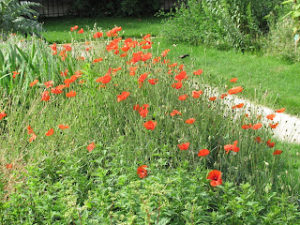
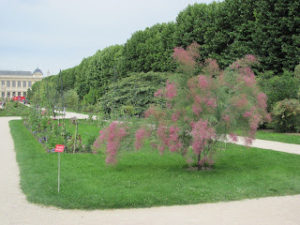
The Alpine garden was the most remarkable in terms of beauty and variety; I even saw some prickly pear cactus in there, along with a few other types of cactus.
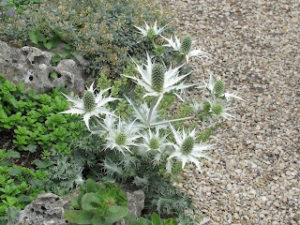
There was also a fairly extensive teaching garden; each area was devoted to a different plant family, with a sign describing each family and naming some representative species. Another area had a sign describing the different leaf types, flower types, etc., with a key to various numbered plants in the nearby beds that exhibited each characteristic. It looked like an excellent educational tool. I also liked seeing the tree of life illustrating how the families of plants are related. This picture is not the greatest (sorry), but it does give you some idea of how it looked.
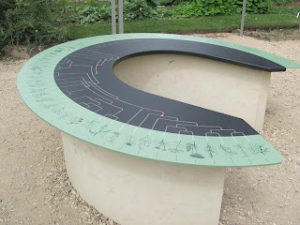
All in all, it was an impressive place. I’m sure I only skimmed the surface; I saw clusters of serious botanists or gardeners gathering to discuss one plant or another, and a number of sketchers were at work in the Alpine garden.
Churches and old buildings! (June 17, 2011)
After I left the gardens, I walked among university buildings and college bookstores toward a couple of churches. The Latin Quarter is a wonderful place. It’s the oldest part of the city, being the site of the Roman town of Lutetia. A lot of the medieval history of Paris is also represented in the street names and some of the buildings. On my way to the first church, I was pleased to spot another bit of the wall built at the command of Philip Augustus in the early 13th century.
The site of the current church of Saint-Étienne-du-Mont has been a place of religious importance since at least the days of King Clovis in the 6th century. The current building is a mix of Gothic and Renaissance elements. The main reason I wanted to see it was its lovely open stonework choir screen and two stone spiral staircases. (The choir is the part of the church between the nave, where people sit or stand, and the sanctuary, where the altar is.) I had certainly never seen anything like it. Here you can see the screen, a bit of the staircase at the far end, and a better view of the staircase at the near end.

Here’s a better view of the near staircase:
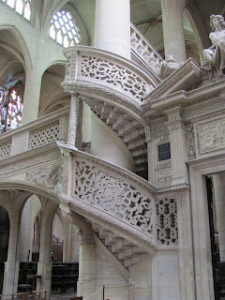
It was impressive as I’d hoped it would be, and this was one of the most beautiful of the churches I’ve visited.
After leaving the church, I walked up the Rue Saint-Jacques, which follows the route of the cardo, the main north-south road, of the old Roman city of Lutetia. (The street was named Saint-Jacques for its association with St. John (Santiago) of Compostela; the street was the beginning of the pilgrimage route to Compostela.) I was delighted to see an old observatory dome; I believe this building is part of the Sorbonne.
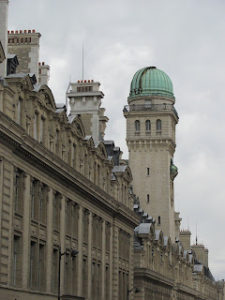
I can’t imagine anyone does any observing from there any more, and I’d be surprised if there’s even still a telescope in there, but it always does an astronomer’s heart good to see a telescope dome.
The second church I visited was Saint-Séverin. I was not quite as taken with it as with Saint-Étienne, but it did have one unusual feature that I enjoyed seeing. Among the forest of pillars you see at the back of the church, one is twisted.
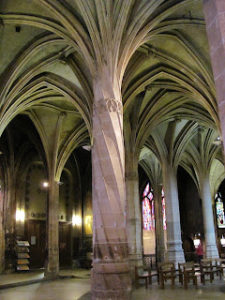
I haven’t read anything about any special significance of this pillar, but it is quite a sight.
I’m going back to the Latin Quarter on Monday to see the Pantheon and the Cluny Museum. That should be a lot of fun.
Footbridge over the Seine (June 17, 2011)
Yesterday when I left the Tuilieries Gardens after lunch, I wanted to get across the river but couldn’t see an easy way across a busy street to the nearest bridge, a pedestrian bridge called the Passerelle Léopold-Sédar-Senghor. There were some steps leading down below street level, so I took them, and found that pedestrians can cross under the busy street and then start climbing up the pedestrian bridge, with the river visible underfoot between the steps. It was very cool. At about mid-river, the stairs of the bridge met the two level spans on either side. This image shows how it works.
When I got to the other side of the bridge, I was happy to see Thomas Jefferson.
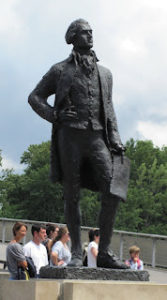
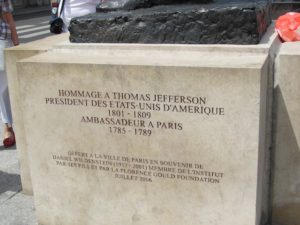
It’s a busy corner, so it was impossible to photograph the statue without at least a few passers-by. When Jefferson visited Paris, my understanding is that he brought home a lot of wine and a lot of books, which did not improve his financial situation any (although perhaps some of the books wound up in the Library of Congress). I can certainly see how easy it would be to bring home a lot of books and wine.
One more note about the bridge: On a few of the bridges over the Seine, it has somehow become customary for lovers to fasten a padlock to the structure of the bridge and then throw the key into the river in order to symbolize their commitment to each other. I hear that the city is trying to discourage this practice, and the bridges appear to be cleaned off periodically, but there are still plenty of padlocks on a couple of the bridges, including this one. As I walked across, I noticed that some couples write their names, and maybe a date, on the padlock. I wish them all well. While we are on the subject of lovers, I will note that I have seen more public displays of affection (not just pecks on the cheek but serious kisses and hugs, tender farewells, and making out on park benches) in the past week and a half in Paris than probably in all my years of living in a college town.
Motorcycles (June 18, 2011)
Another surprising thing about Paris is the number of motorcycles. Once I thought about it, I could see why they might make more sense in the city; they are probably easier to park and cheaper to run. I’ve gotten used to seeing lots of them around. However, this afternoon on my way home I saw (and heard) what seemed like every single motorcycle in Paris heading down Rue St. Antoine, horns honking. (Rue St. Antoine is part of my standard route home.) There must have been hundreds if not thousands of them.
I walked several blocks with motorcycles streaming by the whole way; when I got to the Monoprix to do some shopping, I could hear them going by outside for another 10 minutes or so. Then I went downstairs to finish my shopping; I was down there for a good 20 minutes or so, because it was Saturday evening and the place was packed. As I headed for the exit, I thought that surely all the motorcycles would be long gone, but when I got to the street, they were still going by. I had to dodge them to get across the street. I found a news story in a Paris paper online about motorcycles rallying to protest some new traffic law, so my best guess is that that’s what it was all about, but my French is not good enough to figure out what the new law does. The news story said that 15,000 motorcyclists were rallying, a number I might treat with some skepticism if I hadn’t seen a steady flow of them apparently going by for about half an hour.
Montmartre and music (June 19, 2011)
Yesterday I visited Montmartre, which was originally its own separate village and is now basically a suburb of Paris. Montmartre is located on and around the highest point in the city, butte Montmartre. We climbed and climbed and climbed along a gently curving, seemingly endless stairway—and that was just getting out of the subway station. We took a nifty funicular to the very top of the hill. The basilica of Sacre Coeur is there (a bulbous white 19th-century church, beautiful inside but somehow not very inspiring after all the much older cathedrals), and wonderful views of the city. The area right around the church is touristy, and also full of those who prey on tourists, but away from there, the place reminded me a bit of San Francisco: steep streets good for slow strolling and lined with charming buildings.
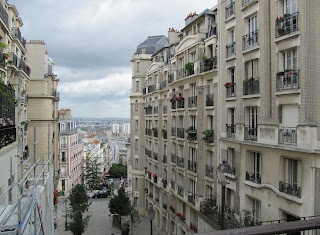
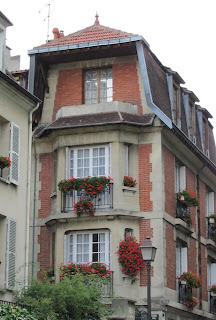
There’s also a famous vineyard; evidently grapes have been grown here and wine has been made for a very long time, and the vineyard still yields a small harvest every year.
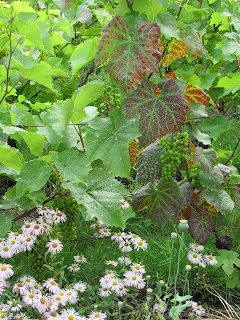
When I moved to the midwest years ago, people told me that if you don’t like the weather, stick around 15 minutes and it will change. That was almost literally true of Paris yesterday. There were periods of blue skies and a few billowing clouds, periods of overcast, and brief but relatively heavy showers, and the weather cycled back and forth between these different states with surprising rapidity. We ate lunch when and where we did to escape from a downpour (which ended shortly after we sat down and was succeeded by blue skies and sunshine until shortly before we left). The rain came and went like that the rest of the afternoon.
Montmartre is known for many things, including its importance as a home for the arts (a number of 19th and early 20th century writers and artists lived or worked here) and also the home to the rather naughty neighborhood of Pigalle. We didn’t get into that part of it; after lunch at a pleasant, relatively quiet restaurant, we headed south and west on a musical pilgrimage through the city.
The biggest music site was the Opera Garnier, a gorgeous 19-century opera house. Opulent is the only word for it. Here is the grand staircase.
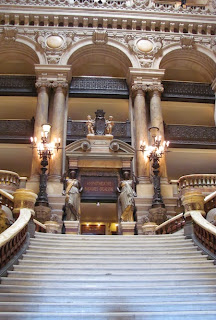
And here is an incredible foyer.
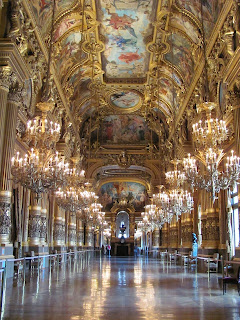
We got a glimpse of the main auditorium, although we had been told it was closed because people were rehearsing in there. The ceiling has murals by Chagall. Someday I have to get back here and hear an opera in this place.
Lesser musical sites included Berlioz Square, where the statue of the composer shows him as quite the young romantic.
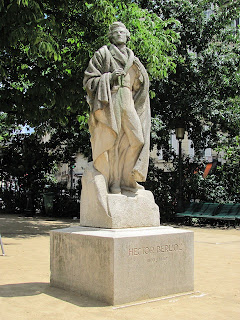
We also visited two of the buildings where Chopin lived (one where he lived with George Sand, and one where he died). The final stop of the day was Saint-Eustache church, where the composer Rameau is buried. (Richelieu and Madame Pompadour were baptized there, Louis XIV made his first communion there, and Mozart’s mother’s funeral was there.) It’s a beautiful late-Gothic building, and we happened upon the end of an organ recital, so we got to hear some magnificent music. (Organ music is wonderful in those resonant old stone spaces.) Outside in a courtyard, a group sang gospel music. At least, they did until it started raining again, and it was time to go home.
More about old places (June 19, 2011)
Before I left for Paris, I wrote about the layers of history that so many buildings and monuments in the city embody. Yesterday I was in the Place Vendôme; it was at number 12, Place Vendôme that Chopin died. In the Place is a column with panels set into it depicting what turned out to be Napoleon’s triumph at Austerlitz, with a statue of Napoleon at the top. The panels were cast out of bronze obtained from enemy cannons captured during the battle. The statue is not the original; the original was supposedly the one that was melted down to replace the statue of Henri IV on the Pont Neuf, which in its turn had been melted down during the Revolution. Paris is a palimpsest.
Another tie between yesterday’s musical pilgrimage and the statue on the Pont Neuf is that Berlioz wrote in his memoirs that when he was on the outs with his family and short on funds, he used to eat his meager dinners at the foot of the status on the bridge:
It was summer. I bought my delicacies at the nearby grocer’s and usually took them to the little terrace on the Pont Neuf, at the foot of Henry IV’s statue. There I sat and, trying not to think of the boiled chicken which the good king wished his peasants to have for their Sunday dinner, ate my frugal meal, watching the sun go down behind Mont Valérien, gazing entranced on the endless play of light and reflection on the waters of the shining Seine as it glided before me … .
I thought of this several days ago when I paused at the foot of the statue, imagining Berlioz on short rations eating there. Henri IV is supposed to have said that he wanted every peasant to have a chicken in his pot every Sunday; although the phrase about “a chicken in every pot” is associated with Herbert Hoover, it goes back much further than that.
More Monet (June 19, 2011)
As of today, I have seen works by Monet in four museums in Paris: the Musée d’Orsay, the Louvre, the Musée de l’Orangerie, and the Musée Marmottan-Monet. (On Tuesday, I will see more in a special exhibit in the Hôtel de Ville.) The Marmottan has the largest collection of Monet’s works in the world, and also contains earlier works, including some exquisite medieval illuminations. At the moment, there is also a special exhibit of 20th century paintings by brothers Raoul and Jean Dufy. The highlight for me was Monet’s work. I can’t say the museum is on my short list of museums to see in Paris, but it’s certainly on my long list. The collection includes the painting which gave the Impressionist movement its name: Impression, Sunrise. It also includes a fair number of later Monet paintings, which are close to abstract. I have to say that I don’t enjoy his very late paintings as much, but I am greatly taken with the fact that he kept on developing and finding new ways to approach his work well into old age.
On the way to the museum from the subway station, in the Jardins du Ranelagh, I saw a statue of the French fabulist La Fontaine that included an illustration of the fable of the fox and the crow. The crow has a piece of cheese in his beak that the fox wants to get for himself. He praises the crow for his beauty and flatters him by wondering if his voice is as wonderful as his plumage. The crow falls for the bait, opens his mouth, and drops the cheese, which the fox gleefully makes off with (off with which the fox gleefully makes? no, I don’t think so).
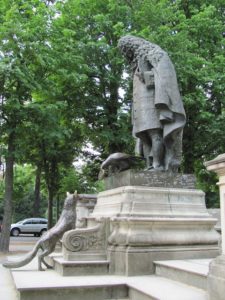
P.S. Random historical tidbit: The Métro stop where I got off for the museum is called La Muette, and it is named for the Chateau de la Muette, three different incarnations of which were built at different times around this area. In 1783, the Montgolfier brothers made the first manned hot air balloon flight from the second Chateau de la Muette, where Louis XVI and Marie Antoinette lived.
Bois du Boulogne (June 19, 2011)
This post is going to have a lot of pictures because I spent the rest of the day in an extremely photogenic place, the Bois de Boulogne. The Bois is a large wooded area on the west end of Paris; it is evidently where Paris goes to exercise, because I saw many runners and bicyclists, including some impossibly adorable small children on small bikes. (The kids wear helmets, although most of the adults do not.) There are two lakes, numerous ponds, several waterfalls, and many, many lovely paths to follow.
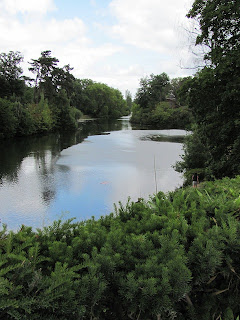
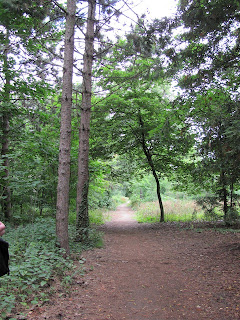
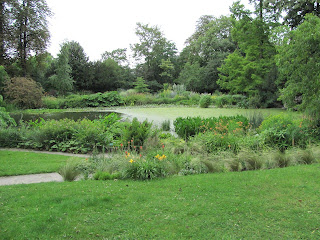
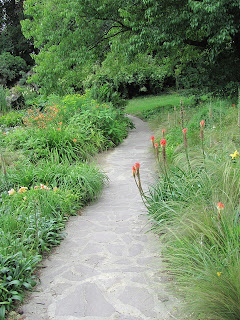
The park does hold some perils, including dangerous trees and the risk of floods. I like the exclamation points in the signs.
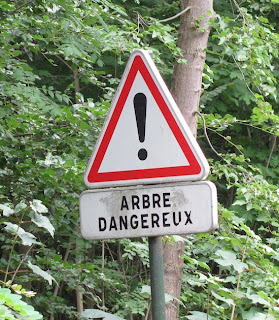

(The trees looked perfectly benign to me, so I’m not sure in what way they were dangerous, and on the day we were there, the risk of a flooded roadway seemed vanishingly small.) All in all, the park is an idyllic setting. The Parc de Bagatelle contains perhaps the greatest concentration of sheer beauty and lovely views. Food, however, is a little hard to find; the first two restaurants we sought out, following a knife and fork symbol on the map, turned out to be costlier and swankier than we had in mind, and we somewhat irritably retraced our steps to find a smaller place that sold sandwiches and crepes. However, good humor was restored when we ran across this guy on the way.
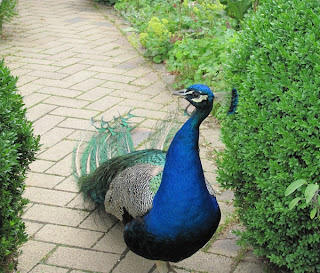
I had never seen a peacock before, and I was greatly impressed by his gorgeous blue color. If I were a peahen, I would not need to see his tail; the lovely iridescent sheen of his chest would be enough. However, being a human, I was sort of curious about what his tail would look like in its full glory, but I didn’t get to see it. I think without a peahen around, the peacock doesn’t bother unfurling the thing, and the peahens we saw were off in the grass away from the peacocks. Still, the peacocks were a glorious sight; we saw several others as we traveled around in the park. Here’s a better view of the tail.
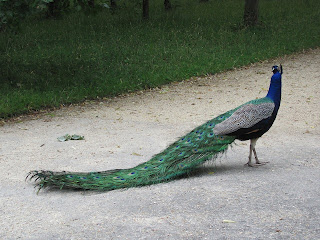
They really are remarkable animals.
Some sort of Chopin festival is beginning today, and I got to hear a couple of young pianists playing Chopin and Liszt in the Orangerie in the Bois de Boulogne. The Orangerie is near the rose garden, which was full of the most amazing array of roses in a range of lovely shades. It was quite pleasant to stroll among the roses on a June afternoon, echoes of Chopin and Liszt running through my head, surrounded by people equally entranced by the roses who all stopped to admire, photograph, and sniff. There is something very endearing about the actions of people who appear to be motivated solely by the love of something beautiful.
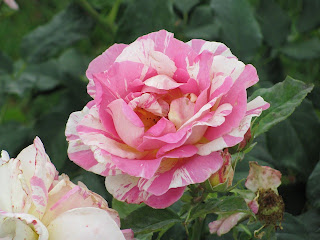

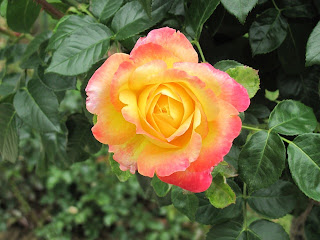
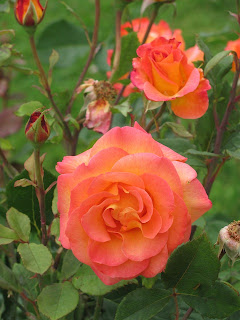
In addition to the roses, the Parc de Bagatelle contained a giant sequoia, a Douglas fir, and a cedar of Lebanon (and of course many other flowers and shrubs). There were ducks and the ubiquitous pigeons as well as peacocks. I joined several of the children near the sandwich place in throwing crumbs to the birds, and the guy at the sandwich place made a bunch of pigeons very happy by brushing a great shower of crumbs off the counter to the ground. To cap it all off, there was even a swan.

I don’t suppose it gets much better than this, but tomorrow I am going to visit the Pantheon and the Musée Cluny in the Latin Quarter, so who knows?
Cluny and Panthéon (June 20, 2011)
Today I visited the Latin Quarter again. First stop was the incredible Musée Cluny. The building that houses the museum, the Hôtel du Cluny, originally belonged to the abbots of Cluny; its long history of construction and renovation began in the 14th century. The museum also incorporates part of a ruined Roman bath complex from the 3rd century, the Thermes de Cluny. So the space itself is impressive, and the museum is full of medieval artifacts, the most famous of which is a series of six tapestries featuring a lady and a unicorn. These are stunning; I had no idea how rich and complex they would be to see in person.
A large, high-ceilinged, and evidently very old room contains some of the heads from the statues of the kings of Judah on the facade of Notre Dame, which were knocked off during the Revolution. The statues on the facade currently have their heads, so I assume they were later replaced, but the original heads were kept here. In this room, full of fragmented stone bodies and often damaged stone heads, two or three singers were evidently preparing for a performance. I got to hear them practicing a couple of songs in that room; they were singing music that was made for those great resonant stone spaces, and it sounded fantastic.
Surfeited with medieval history, I ate lunch in the nearby Place de la Sorbonne and then visited the Panthéon, a huge domed building, originally a church, that now commemorates France’s great men and women. It is an impressive place: massive pillars out front, a monumental interior full of memorials, paintings, and sculpture. This was the site of one of Foucault’s demonstrations of the rotation of the earth using a pendulum, and the building contains a Foucault pendulum that uses an exact replica of Foucault’s original weight.
Of all the things in the Pantheon, though, I think the one that moved me the most was the tombs of the people buried in the crypt. I visited those of Marie and Pierre Curie, Emile Zola, Alexandre Dumas, Victor Hugo, Louis Braille, Voltaire, and Rousseau. Burial there is a high honor for those who have contributed greatly to the country. I guess this is roughly equivalent to Westminster Abbey in England, but I realized that the U.S. doesn’t really have such a place to honor its best and brightest in the arts and sciences, although for political and military leaders, there is Arlington Cemetery. Have we just not had time as a country to develop a customary place to honor artists and scientists?
Paris by twilight (June 20, 2011)
This was my next-to-last day in Paris (hélas!). I spent some time this afternoon sitting along the river on the Left Bank and sitting in the Place des Vosges just soaking up the feeling of being here and watching Parisian life go by. In the evening, I had a nice dinner at a restaurant on the Place des Vosges, Ma Bourgogne, with my friend. I had a salad of mixed greens with toasted goat cheese and croutons, a salmon steak with sorrel and some kind of luscious sauce, and an apple tart flambé. That and some Côtes du Rhône made for a pleasant dinner. We were seated outside, which I enjoyed because we could watch people coming and going in the Place. After dinner, we took a couple of slow turns around the Place, and then someone blew a whistle and said something I didn’t catch, but it was plainly some variant of, “OK, everybody out, if you please!”
The sun sets around 10 p.m. here at this time of year, and the last of the boat tours on the line we took last time leaves at 10:30, so we took the subway a few stops and hastened to the Pont Neuf to catch that last boat. The trip along the river in the deepening twilight was lovely. I took my first boat tour the day after I arrived, and it helped me locate some landmarks and start feeling more oriented. On this trip, I could recognize most of the sights the guide pointed out, and I had memories associated with many of them. The Eiffel Tower was all lit up and shone golden against the deep blue sky—it’s such a lovely graceful structure—and I thought about the view from the top. As we want past the Musée d’Orsay, which houses lots of Impressionist and post-Impressionist art, I remembered the beautiful open space under the arched roof, and all the paintings by Renoir and Monet that I enjoyed seeing. When we were near Les Invalides, I had a quick mental image of the rows of cannons with their nameplates. Notre Dame is impressive at night, and it still gives me a little bit of a chill to catch sight of it. I know most of the bridges by now. Obviously I’ve only begun to know Paris, but I felt very satisfied with what I have learned about the city in these two weeks.
One of the things I love about Paris is how accessible the river is. In addition to sidewalks on all the streets along the river, there are walkways at a lower level, right near the river, and plenty of benches and steps to sit on. I was surprised, tonight, to see how lively these spots all were, even at 11 at night. At the western tip of the Île de la Cité, there’s a beautiful park called the Square du Vert Galant, where I have sat a couple of times enjoying the peaceful green space. Tonight the park and the river bank were full of people, some of whom waved at the boat as we went by. Some of us on the boat waved back, and next thing you know, one of the young men on the river bank was mooning us and all of us on the boat were laughing. I don’t believe I’ve ever been mooned before, and it seems peculiar to me that Paris is the first place it should happen.
Near the place where I sat on the river this afternoon, I had noticed some circular open spaces surrounded by several rings of concrete seats, almost like very small amphitheaters, and I wondered if anyone ever performed chamber music or anything like that out there. Tonight I saw couples practicing some kind of ballroom dance in one of these spaces. I’m going to miss this place.
Music! (June 21, 2011)
Today was a relaxed but somewhat bittersweet day: breakfast at a sidewalk cafe, a walk to one or two new spots in the neighborhood, and a visit to some of my favorite places, including some time spent sitting and watching the river go by. I also made a few last purchases (mostly chocolate to bring home for friends). Then it was back to the apartment to pack and clean the place up a bit.
This evening when I went down to take one last stroll through the Place des Vosges, I found the place bubbling with activity. I knew there was a city-wide music festival today to celebrate the summer solstice, but I didn’t realize there would be so much music in this neighborhood. Instead of taking a slow quiet walk, I wound up following a marching percussion band around the outside of the square with the rest of the crowd and then moving from band to band (klezmer, a drumming circle, what sounded like American folk and several types of French folk, etc.). I would guess there were 6 or 8 different groups around the square. The park emptied out peacefully at its normal 9:30 closing time, but the music continues on the streets surrounding the Place. There are amplified rock bands at either end of the street the apartment is on (I just heard an energetic version of “I Will Survive”), so I suspect it will be a noisy night here. We’re leaving for the airport at 5:30 a.m., but I don’t really mind the ruckus. My last memories of this visit will be of my borrowed Paris neighborhood ringing with music and of people singing and dancing and enjoying the long summer evening. What a perfect way to end my stay here.
Helsinki again (June 22, 2011)
Well, the homeward trek has begun. I left the apartment slightly before the crack of dawn this morning and left Paris around 7:45. Now I’m in Helsinki awaiting my flight to New York, which leaves in a couple of hours. Traveling east to west is always easier than traveling west to east in terms of the time change, in my experience, but it will be a long day (arrival in Bloomington about midnight tonight, which is 26 hours after I woke up this morning).
In the last day or two in Paris I started reading Edmund White’s La Flâneur, a copy I picked up at the Red Cross book sale and had no idea I would be reading in Paris a few years later. I finished it on the plane. White says a number of things that I am mulling over, particularly as I compare my experiences in Paris with my life in the U.S. (I’m really trying to understand why I felt so much at home in Paris; I expected to enjoy it there, but I didn’t really expect to feel so comfortable right off the bat.) One thing that struck me in particular this morning is a point he made about identity politics. This was in the context of a discussion about why France was so slow in the 1980s to recognize the seriousness of AIDS and to begin educating the public to slow the spread of the disease. He associates this phenomenon with the absence of a recognized gay activist community and goes on to talk about the French attitude toward interest groups in general.
The French themselves would argue that their rejection of all ghettoization, far from being a sign of closetedness or cynicism, is in fact consistent with their ‘singularity’ as a nation. The French believe that a society is not a federation of special interest groups but rather an impartial state that treats each citizen—regardless of his or her gender, sexual orientation religion or colour— as an abstract, universal individual. For the French any subgroup of citizens is a diminishment of human equality.
He goes on to point out that the only problem with this attitude is that the rights of particular groups are not always defended. It’s a good point, particularly in context, but I think I can still see things to admire in the French viewpoint as he portrays it. For all my interest in women in science, for example, when I was studying astrophysics I didn’t like being seen as a woman scientist. The label seemed to imply that it was somehow important to note that I was a woman, whereas in my view a scientist is a scientist, and the useful labels are things like “botanist’ or “astronomer” and adjectives like “theoretical” and “experimental” (perhaps nationalities are useful labels if particular countries or locations are known for working in a specific area?). (Roughly the same idea applies to the labels “woman writer” or “woman blogger.”)
I can see the need for people (men and women both) to encourage not just women but other underrepresented groups to consider a career in science if they’re interested in it, which I suppose is a form of community action, but I’ve always been leery of identifying myself as a female anything. What I really needed when I started back to school at 23 to study science was financial aid directed toward returning students with children and advice and help for those coming to astrophysics poorly prepared in high school; women are not the only ones who need these things. Are women scientist interest groups the best way to get this kind of support for women? It’s arguable, but I don’t really think it’s the only way. (Also, you have only to look at the history of feminism to realize that just because people are women and interested in women’s rights doesn’t mean they all agree on a common identity or platform. I think it says a lot that many people hesitate to use the word “feminist” to describe themselves, or they say, “I’m a feminist but…”. Is there a way to rally together for common causes without falling prey to stereotypical images, often derogatory, that most definitely do not do justice to the complexity of human individuals?)
I’m not sure how applicable any of this is to White’s argument about HIV/AIDS education and prevention, or to the French attitude toward identity politics, but what he said struck a nerve with me, and here I sit in Helsinki with some time to write. I’m muddle-headed from dramamine and not sure this will make any sense to me tomorrow, but what the hey. You can all tell me what you think anyway.
Back home (June 23, 2011)
I said in my last post that it would be around midnight when I got back to Bloomington, but it was actually nearly 3 a.m., around 29 hours after I woke up in Paris. The last flight of the day, New York to Indianapolis, was delayed by a couple of hours, for reasons I never did entirely understand. (My overall impression of JFK last night was that no one really knew what was going on.) If any of the six flights making up the trip had to be delayed, that was the best one for it; it didn’t involve missing any connections or missing out on time in Paris. But still, JFK is not a place that makes you feel like it’s good to be in the U.S.
The European part of the trip was great, though; Finnair treats its passengers very well, even the ones in economy. Despite a glimpse of Iceland and an excellent view of Greenland on the long haul over the North Atlantic, the afternoon seemed to go on forever (we left Helsinki at around 2:00 in the afternoon and arrived in JFK, seven time zones to the west, around 3:45 or so). I was very grateful when, about two hours before we reached New York, the flight attendants came down the aisle, plucking piping hot wet paper napkins out of a basket with a pair of tongs and dropping one on each passenger’s tray. Next came a sandwich; this was in addition to a tasty hot lunch at the beginning of the flight. If you are going to spend 8 hours or so at 30,000 feet, Finnair seems to be a good option.
Favorite memories of Paris (June 24, 2011)
So many memorable things happened on this trip! Some moments big and small stand out as being particularly moving, amusing, or enjoyable:
- First catching sight of Notre Dame from across the river
- Seeing a small boy chasing a peacock in the Parc de Bagatelle in the Bois de Boulogne
- Eating a warm Nutella crepe (my first crepe) on a chilly gray morning in Montmartre
- Eating lunch on a Sunday afternoon on the Île Saint-Louis with street music going on all around me
- Sitting in the Arènes de Lutèce, the remains of a third-century Roman amphitheatre, which I believe is the oldest structure I’ve ever sat in
- Seeing the foundations of part of the 12th-century fortress from which the current Palais du Louvre eventually grew
- Emerging from the Église Saint-Merri and being amused to see a shop selling sex toys directly across the street
- Walking in the Latin Quarter, spotting a remnant of the 13th-century wall built at Philippe-Auguste’s command, and being able to guess what it was before I read the sign
- Conducting an entire, if very brief, conversation in French on my last day in the city (it was about where the restroom was, but still)
- Walking into a large bookstore (Galignani’s) on the Rue de Rivoli
- Offering a crumb to a little brown bird that hopped up onto the table when I was eating a flan outside a bakery on the Île de la Cité
- Seeing the Eiffel Tower at night from the river
- Negotiating my first relatively complicated subway station on my own
- Seeing the Seine flowing beneath my feet as I climbed the stairs on the lovely footbridge, the Passerelle Léopold-Sédar-Senghor
- Coming across some of my favorite Monet and Renoir paintings in the Musée d’Orsay
- Spotting the telescope dome at the Sorbonne on the Rue Saint-Jacques
- Joining the crowd following a group of drummers around the Places des Vosges on my last night
I’m sure I will think of many more as soon as I post this, but c’est la vie.
The logistics (June 28, 2011)
There are probably as many paths through the City of Light as there are people who visit. My path centered on history, art, music, and literature, with an emphasis on walking. If you ever visit Paris, I’m sure your path will differ from mine. Still, it seems worth offering a bit of detail about the logistics in case anyone is interested.
Lodging. The apartment was rented through Untours, which arranges apartments for one- or two-week stays in various enticing parts of the world. The idea behind an Untour is that your path is smoothed considerably by the expertise and support of a local guide, but you are on your own as far as planning your itinerary and living your days as you like. The two-week stay in Paris came with transportation to and from the airport (reliable and cheerful even though our outbound flight left at 7:40 a.m.), 20 Métro tickets apiece for me and my traveling companion, a five-day Paris Visite pass each (this pass allows you to ride the Métro and the RER trains), a two-day museum pass apiece (we bought additional four-day passes), and the dinner I described on our first full day in the city.
Untours has several apartments in Paris, and at the dinner we met everyone else who had just arrived for a one- or two-week stay in one of them. Our guide, Jennifer, met our plane and provided helpful information about food, shopping (of the everyday where-do-I-buy-soap variety), and riding the Métro; at the orientation before the dinner, she brought information about various day trips from Paris (Giverny, Chartres, Versailles, etc). Our apartment had wireless Internet access, and when we had trouble figuring out the password, someone showed up to help us before I realized my friend had even called for help. All in all, I can wholeheartedly recommend Untours if you would like a similar experience not just in Paris but in various other cities.
Day trips. We debated over the various possible day trips, reluctantly rejecting Giverny as probably too crowded at that time of year. We visited Chartres and Versailles on the same day, which is not advisable if you want to see Versailles in depth, but worked out fine for us; we were most interested in the gardens. It might be nice to go back for a full day sometime to see the Grand and Petit Trianons, but I was quite happy with what we did see. Although I enjoyed our relatively brief visit to Chartres, I also would not mind spending a full day there, visiting the stained glass museum and perhaps attending both of Malcolm Miller’s tours (noon and 2:45 daily except for Sundays, €10 a head when we were there). He is said to never give the same tour twice on the same day, and at the end of the tour we attended, he promised to be there until the Judgement Day, so maybe I have another chance at catching both of them in one day.
Music, etc. My friend Jay is a music theorist, and he found a site that lists information about classical music concerts in Paris. We booked the chamber music concert in the Saint-Chapelle and the Orchestre de Paris concert in the Salle Pleyel before we left; the opera was all booked up. When you are in Paris, it is also well worth keeping your eyes peeled for posters advertising classical music concerts in Paris’s many cathedrals and churches; I saw flyers up all over the place for various events that I wish I had had time for. Every Wednesday a new Pariscope magazine comes out and is available at news stands and book stores. (Jennifer gave us one at the orientation session, and I bought one for the second week; that second one led us to the free Chopin and Liszt at the Bois de Boulogne.) It lists not just music but also theatre, cinema, and other entertainment possibilities in the city. As far as music both classical and non-classical goes, the music festival on the solstice looks like a lot of fun from the little I saw of it.
Guidebooks. As I mentioned earlier, Rick Steve’s Paris 2011 was an invaluable guide, and his free audio walking tours can guide you through the Louvre, the Orsay, Versailles, and historic Paris. (I did not use any of the tours while actually navigating these places, but I gleaned information from them before the trip. I did use the maps and commentary in the book for guidance at Versailles and Chartres, and consulted the book regularly while I was in Paris.) I also enjoyed the information and maps in Paris From the Ground Up by James H.S. McGregor. If I hadn’t read this book, I never would have known about Philippe-Auguste’s wall or the foundations of the towers of the original Louvre.
Walking tours. Our walking was all self-directed. Jay downloaded maps to his iPhone, so I could enjoy gawking at the buildings or the river or the people to my heart’s content without getting lost because he consulted his iPhone and kept us on track. On my days on my own, I memorized a few key points of the route (Métro stops, street names) and winged it from there, consulting my Frommer map as needed. I wish I had had the time to take advantage of Paris Walks. These English-language walking tours come highly regarded, are not expensive, and offer many opportunities to explore particular neighborhoods or themes. When I go back, I definitely want to take the chocolate tour.
Food in Paris (July 1, 2011)
Before I went to Paris, I somehow gathered the impression that restaurant meals typically last a couple of hours, and that the American tradition of carry-out is not to be found. Maybe in the higher-end restaurants, meals do run long; the dinner hosted by Untours on the first full day of my stay lasted for three highly pleasant hours, from kir to raspberries with whipped cream (there were about 10 of us at dinner that night). But even our most expensive meal, the dinner at Ma Bourgogne (€91 for dinner for two and a carafe of wine, which is nowhere near the high end of luxury dining) didn’t last more than about an hour and a half. Carry-out is everywhere to be found, and although it often was tourist food (sandwiches and crepes any place tourists gathered), it also seemed to be pretty standard Parisian practice to grab something at a bakery and eat it in a nearby park or maybe at a table outside. I enjoyed many such meals and came back with ideas for quiches I want to make at home. Spinach and goat cheese quiche seems to be a staple, as does salmon quiche. I had a very nice slice of quiche Lorraine in Chartres.
I lacked confidence in my French and thus missed some opportunities to dine in restaurants or visit wine bars where I would have been called on for something more complex than “Je voudrais une tranche de cette quiche, s’il vous plait” or my absolute favorite, “Un comme ça, s’il vous plait.” (That’s one reason I want to go back, so I can build my language skills and try out more of the food and wine on offer.) Still, I had some excellent restaurant meals, which I obtained by a combination of using what French I had and pointing at the menu. I had some great salads and omelets, and I noticed that ham seems to play a crucial role in many dishes. I read online that you can find vegetarian food fairly easily in Paris, but if you are asking whether a salad includes meat, you need to ask about ham specifically, as Parisians will sometimes describe a salad as meat-free even if it contains ham. Evidently ham is not always considered meat. I find this a somewhat sympathetic viewpoint; for years I have joked that pepperoni is not a meat but a condiment. At any rate, although I generally do not eat meat, I ate plenty of ham in Paris, and it ranged from OK to very good. Paris might be navigable for a vegetarian, but in my experience, being a vegan would take a fair amount of work. Most of my bakery take-out meals were either sandwiches with cheese on them (my favorite was a baguette with fresh mozzarella, tomato, and basil at the Tuileries Gardens) or quiches of all kinds, which of course contained eggs and cheese.
Regarding the menu: You must remember to call it “la carte,” because “le menu” is typically a set course of dishes at a fixed price, which might or might not be what you’re after. In my experience, it does not hurt to ask specifically for the menu after you are seated. One of the more perplexing moments in dining was at a place near the Musée d’Orsay. I think people stopped in there for drinks alone as well as for meals, which we did not grasp right away. We seated ourselves, and when the waiter came to our table, there was a moment of awkward silence until he asked, “Vous voulez manger?” We hadn’t realized that it wasn’t obvious that we were there for lunch, and were briefly taken aback by the question, but managed to say that yes, we wanted to eat.
I bought my wine at the Monoprix, which had a small selection of bottles out on shelves in the regular grocery area but also had a little cave, or wine cellar. I enjoyed everything I bought there. I also gazed into the windows of the wine shops, but never did go into one. Next time.
Language was really not all that much of a barrier when it came to food. It is worth noting that I experienced absolutely no rudeness. If you start out with your best French, at least a hearty “Bonjour, madame” or “Bonjour, monsieur” and as much French as you can muster thereafter, my experience is that people will meet you at least halfway. I have to admit that I didn’t always get what I expected, especially when asking for bread, but I liked everything I got. And how often can you say that?
Paris and cosmic rays (July 4, 2011)
I just stumbled across this Scientific American blog post, which describes early 20th century efforts to understand the source of a newly recognized and mysterious radiation: did it come from radioactive elements in the earth, or from the sky? The Eiffel Tower was crucial to the story of how one scientist obtained the first significant evidence that some of this radiation (what we call cosmic rays today) originates well beyond our atmosphere in cosmic events such as supernovas. I had no idea that Gustave Eiffel argued that the tower had potential as a scientific research station, but he was correct. (One of his suggestions was that an observatory be placed at the top of the tower. I love this idea, but the lights of Paris—not to mention the lights on the tower itself—would make observing most objects very difficult. I wonder if there are any efforts to make the City of Light more dark-sky friendly?)
Bathrooms in Paris (July 5, 2011)
I suppose a logical corollary to any discussion of food and drink is a discussion of bathrooms. Public restrooms are indeed, as I had heard, much more scarce in Paris than in most big US cities. However, although I often had to wait in line for a public restroom (nothing new there; I’m a girl so I’m used to it), and sometimes even pay to use one (typically half a euro or less), the European restrooms I saw were much more private, and I never encountered a really dirty one. The doors and walls in the stalls typically go clear down to the floor, which was a pleasant surprise.
In an apparent response to the bathroom scarcity, public toilets appear in surprisingly roomy sanisettes at random intervals along Parisian streets. (The standard model evidently does not accommodate wheelchairs very well if at all, but for a public toilet sitting in the middle of the sidewalk, they are more spacious inside than I had expected.) A map of the neighborhood typically appears on the outside of the sanisette; as you approach one, you may be unsure whether the people clustered outside are waiting to get in or just consulting the map. These unisex bathrooms are cleaned automatically after every use. Many of them are free, and my understanding is that by 2014 all of the ones in the city of Paris will be free.
The first time I used one turned out to be one of those adventures that are more amusing after than during, but the second time was much nicer. For starters, the first time I used one, it took me a long time to find one so I was mildly stressed to start with. Then I was not sure the door was locked. After I got in and pressed the “close” button on the inside, I couldn’t understand the voice that greeted me in French as soon as the door was closed, mostly because it startled me to be spoken to at all. I wasn’t sure if it was telling me the door was locked or telling me to lock the door, and I couldn’t see an obvious “lock” button. So it wasn’t 100% clear to me that I had done all that was necessary to avoid being walked in on, and I was on a very busy street corner. (I learned later that as soon as you close the door, the “occupied” light comes on outside, and you are safe. I realized later that the button with a pictograph obviously representing someone talking would probably have repeated the most recent message for me, but at the time all I could think of was that I hoped it wouldn’t talk to me any more. I hear that some play music.)
Here I must say a word about French toilets. All the ones I saw were designed to be low-flush, and hence were more cylindrical than the ones in the U.S., with smaller tanks. You almost always have a choice of two buttons to push to flush, depending on whether you want a big flush or a little flush. Either way, the tank seems to fill up quite quickly afterward, leaving me feeling, back here in the States, like my toilet is a huge water hog because the tank takes forever to refill. (I never saw a normal-flow toilet anywhere in Europe, which made me wonder why the low-flush technology hasn’t caught on more in the southwestern US. I really did like the low-flush toilets, and I’d like to install one in my house.)
So in my first sanisette, I pushed the small flush button, and nothing happened except that a voice told me something useful. I was fairly rattled by this point; I got that it was telling me I had chosen an option that conserves water, but I couldn’t figure out the rest. Maybe it’s telling me the little flush is out of service? I pushed the big flush button, and got another useful response in French that went over my head, and then pushed the small button again once or twice, waiting for something to happen. Eventually I gave up, washed my hands, and departed, befuddled. I believe now that nothing happens until you push the button to exit, and then the bathroom goes into flushing/cleaning mode in preparation for the next person. I hope it took my multiple button pushes in stride.
One last word on this indelicate but essential subject. I had read online that toilet paper is often scarce in public restrooms in Paris, so I brought along about a dozen of those small packets of Kleenex that you can carry in a purse or pocket. For what it’s worth, I never needed to use any of them. Even if I had needed some, I probably wouldn’t have needed a dozen packets, so this was definitely overkill. At least I’m all set for the allergy season.
Whose streets? (July 5, 2011)
Ever since I’ve arrived back home, I’ve been trying to articulate something about why the streets of Paris felt so comfortable to me. Part of it has to do with the fact that they seemed very well used and very well looked after. My first Sunday in Paris was Pentecost Sunday, which I was told was still a big enough deal in France that some things might be closed. (As it turned out, the only closure I ran into was the crypt at Notre Dame.) Still, as I walked through my neighborhood at around 8:30 or 9 in the morning, I saw what looked like city employees out sweeping and hosing down the streets. I saw plenty of shopkeepers or other staff keeping the sidewalk clean in front of a shop. Cigarette smoke was about the only thing I encountered that I found really unpleasant, and there wasn’t as much of that on the streets as I had feared. (I think smoking is no longer permitted in some indoor venues, for which I was thankful.) I had read about problems with dog poop on the sidewalk, but I saw very little of that. I don’t remember seeing much litter either, other than cigarette butts and sometimes Métro tickets.
People were generally polite; I was very rarely on a street that had no other pedestrians, and as heavily traveled as the streets were, everyone had to be polite to keep the experience from being miserable. What I felt was a subtle but distinct sense that the streets belonged to the people who were walking on them, and it was important that they be pleasant places.
In some parts of the U.S.—not everywhere, but it’s not uncommon—public areas seem like something you have to get through to make it from one enclave to another, a sort of no-man’s-land that might or might not be well-tended or pleasant. An enclave might be home, an office, a store, or a mall: someplace that belongs to a distinct entity. Public spaces often feel like an afterthought. Theoretically they belong to all of us, but here that sometimes seems to translate into belonging to no one.
Even in Bloomington, which is not a dirty city, you run into trash, especially fast-food trash, on the sidewalks. Several summers ago, it took me months to find out who was responsible for a path that I used to walk to work every day; trees and shrubs were growing over the path, making parts of it impassable and pushing pedestrians into tall grass bordering a shallow ditch along a busy street. Eventually someone figured out who the owner was and told him or her to fix the problem, which he or she did, in what struck me as the most begrudging way possible (someone showed up with a back hoe to trim the shrubbery, which of course looked for weeks like…well, shrubbery trimmed with a back hoe).
Maybe property owners in Paris have the opposite complaints, about official entities who are forever hounding them to keep their property from infringing on public comfort; I don’t want to romanticize the city just because I know it so little. All I can really say is that because so many people walked and took the subway, and because parks or green spaces were everywhere, and because most people seemed to treat public streets and even subway stations as worthy of a certain amount of respect, the experience of being out and about felt very good.
I’m reading The Most Beautiful Walk in the World: A Pedestrian in Paris, by John Baxter, and was struck by the following passage. He is describing the ease with which Parisians navigate the streets compared to new visitors:
Well, this is their habitat, their quartier, as familiar to them as their own living room. Because that’s how Parisians regard the city—as an extension of their homes. The concept of public space doesn’t exist here. People don’t step out of their front door into their car, then drive across town to the office or some air-conditioned mall. No Parisian drives around Paris. A few cycle. Others take the métro or a bus, but most walk. Paris belongs to its piétons—the pedestrians. One naturally goes à pied—on foot.
I have to disagree about no Parisian driving; I’m pretty sure a lot of those motorcycles I saw belonged to Parisians, and surely not all the cars belong to visitors. But still, this echoes a lot of the things I’d been mulling over and trying to articulate. It’s no wonder the place felt like home to me; any place that belongs to its pedestrians is bound to!
Midnight in Paris (July 9, 2011)
This weekend I finally made time to see Woody Allen’s latest movie, Midnight in Paris. It is such a loving and gorgeous tribute to the beauty and romance of the City of Light that I found my eyes filling with tears during the opening sequence, a leisurely tour of various Parisian streets and monuments set to “Si tu vois ma mère” (written and played by Sidney Bechet, although I can’t find the name of the orchestra he was playing with). I thought to myself that if the movie went on like that for another hour and half, sans action, I’d still sit there and watch it.
But of course I loved the story too. (Spoiler ahead!) It’s long on magic and charm, with a bit of mystery that is simply part of the magic and needs no explaining, a Parisian time travel fairy tale for grownups. A group of Americans (Gil, a successful screenwriter who wants to write serious fiction, Inez, his bossy, crass fiancée—no, I didn’t like her, but she wasn’t meant to be likable—and her conservative parents) are visiting the city on business. Gil falls in love, not just with the 21st century Paris he’s staying in but with the 1920s Paris he somehow visits every night.
The differences between the life he wants to live and the one Inez pictures for them are obvious early on, but it takes him a while to sort out which world he belongs in: Jazz Age Paris, the expensive Malibu home and lifestyle that Inez wants, or 21st century Paris by himself. I was enchanted by the scenes set in the 1920s (and in la Belle Époque, which he also visits briefly), and of course I was delighted to see present-day Paris, too, especially so soon after my own visit. Although the characters are sometimes painted with broad brush strokes, the movie is witty and observant and thoroughly enjoyable. And in the end, Gil makes exactly the choice I would have made in his situation.
The timing on this movie happened to be perfect for me; it’s a love letter to a city that I have just fallen in love with. It’s also about themes that have always resonated for me: time, memory, the pull of the past, the appreciation of the present. For all the nostalgia in which the movie is steeped, it ends with a message of hope for the future. Speaking of nostalgia, it was interesting to see which things made me most nostalgic for the city. It wasn’t just the obvious things, like the river and the buildings I recognized and the sidewalk cafés, but little things like the street names on the sides of buildings, the green crosses marking pharmacies, the Vélib’ stands with rows of bicycles available for rent. This sparkling tour of Paris past and present left me thinking of how I can spend more time there in the future.
Waking up in Paris (July 18, 2011)
I continue to process my memories of the Paris trip and to try to fit my experiences into my existing mental framework. I’m also going through some of the photographs that I did not put in this blog on the day I took them. However, I want to start with a photograph taken by my friend and traveling companion Jay Hook.
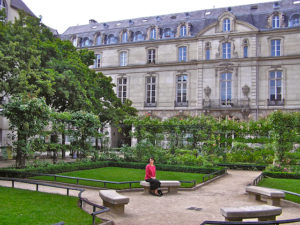
This was taken on the morning of the first day I woke up in Paris. That morning we set out, eager and curious, to explore our new neighborhood, the Marais. What is so touching to me about this photograph is that I wanted to be photographed in such a photogenic, beautiful place, and I didn’t really grasp that I would have many, many opportunities to sit in beautiful squares and parks and be photographed. (And sitting is, of course, the yin to walking’s yang, the other half that gives the first half much of its meaning.)
I had thought of Paris as a sort of highlights reel, and for all the planning we did, I thought we would hasten on foot from highlight to highlight. Before we left, I noted particularly lovely or noteworthy streets to walk down, but I didn’t really understand that so much of the city was going to be such a pleasure to walk in, even the parts in between all the places I noted as special. Of course there were busy streets and traffic and crowds, but I was never very far from someplace like this, and even on the busy streets, the buildings were more often than not eye-catching, harmonious, and beautifully proportioned. The streets themselves were often lovely, either narrow and picturesque or broad and tree-lined.
Before I went there, I think I saw the city as something like a landscape where humdrum flat areas are punctuated by mountain ranges. On this first morning there, I thought this square was one of the mountains, a high point in the landscape. I didn’t realize that to a large degree, it was the landscape, the quotidian experience awaiting me when I stepped out the door.
Until Jay told me, I couldn’t remember the name of this particular place, charming as it was, because I sat in so many like it. (For the record, the photo was taken in the Jardin Saint-Gilles-Grand-Veneur.) The monuments and churches and museums and big gardens were high points, but they were more like individual peaks in the Himalayas than like the Rockies rising up from the Plains. I can’t help wondering how my perspective on the city would change further with prolonged exposure.
Paris, I miss you (June 11, 2012)
This time last year, I was in Paris. The anniversary of the day I flew out came and went last week, and I find that trip haunting me in a way that few trips ever have. (One year ago today, my schedule included Notre Dame, lunch outside within sight of Pont St. Louis, where a few musicians were playing, a concert at Sainte-Chapelle, and a twilight walk home across the Seine. No wonder I’m feeling nostalgic.) I am homesick for a foreign city. This seems like as good a time as any to write up a list of some of the things I want do on future visits to Paris:
- Spend a sunny afternoon in the Luxembourg Gardens with a book.
- On the summer solstice, hear as much of the music festival as I can.
- Stay long enough in the city that it makes sense to take a couple of weekend train trips someplace.
- Visit a wine bar.
- While away an afternoon people-watching and writing at a Left Bank café, and then do the same thing the next day at a Right Bank café for comparison.
- Take more long walks by the river.
- Go to the top of the Eiffel Tower on some gray winter afternoon when there’s no one there and look at the city in peace.
- Visit a flea market.
- Rent a bike from Vélib’ and ride through the streets of Paris.
- Revisit the Musée d’Orsay now that the construction there is (I assume) finished.
- Have a conversation with a Parisian that goes beyond “Où sont les toilettes?” or “Un comme ça, s’il vous plait.”
- Spend Christmas in Paris.
- Visit Sainte-Chapelle on a sunny day.
- Learn where to shop for ordinary things like socks and toothbrushes and cheap pens and spiral-bound notebooks.
- See some of the museums that were closed when I was there last year (the Musée Picasso, the Musée de l’Homme).
- Visit more of the side streets, squares, gardens, and small museums that are off the tourist circuit. Enjoy the hidden treasures I find, knowing that I will never see them all.
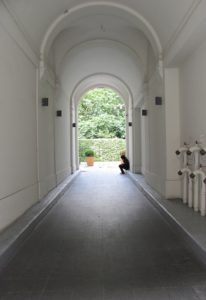
The Panthéon as a humanist monument (May 22, 2014)
I felt a particularly strong hankering for Paris after reading this article by Kevin Dolgin at TheHumanist.com. After noting that Europe, and in particular France, are in many ways more congenial to humanists than the U.S., the article sketches the history of the Panthéon, France’s secular monument to some of its greatest people, and describes its ambiance. I remember being moved as I walked through parts of the crypt, and this piece captures the feeling very well:
Churches do inspire awe, they are humbling, and are perhaps designed to make one feel small in the presence of God. The Panthéon has a similar effect but is devoted to an altogether humanist ideal: feeling awe in the presence of human greatness. Where a church belittles humankind in comparison to an abstract divinity, the Panthéon celebrates humanity: one inspires submission, the other emulation.
History again (May 22, 2014)
On my last morning in Paris, I revisited the Square du Temple and noticed something I hadn’t seen before, a plaque commemorating the Jewish children who were transported from Paris to Auschwitz, betrayed by collaborators during the Vichy regime. It listed the names of children, from the Marais I think (the neighborhood I stayed in), ranging in age from a few months to maybe 6 or 8 years. My eyes filled with tears when I read the closing sentence, which read, as nearly as I can recall, “Nous les oublions jamais” (We never forget them). It always strikes me with a peculiar poignancy when humans, short-lived and forgetful creatures that we are, talk about never forgetting.
Nearby, little kids played in a sandbox, and two very small girls in rain boots stamped their feet delightedly in a puddle. The contrast was so obvious between those long-ago children transported to their deaths, and these children today playing happily. I don’t know to what degree the average Parisian remembers the Jewish children who were lost, or the Occupation, but it strikes me that in the U.S., we largely see history as something that happens somewhere else. Our losses in Vietnam and Iraq, as fearful as they are, pale in comparison to those of the people who live in those countries.
Even to me, my infatuation with historic sites can seem a bit empty: so what? And I can see that living in the shadow of the past can be constricting, compared to the new horizons that seem to be implicit in the American dream. Why go through life burdened by the memory of what happened in this place decades ago, or hundreds of years ago? But the presence of all of history, both the good and the bad and the way it’s woven into life even if people are not totally conscious of it, may be part of what resonated for me about Paris. When you know about some of the mistakes humans have made, maybe you’ll think twice about repeating them.
[I never published this in the original blog, but I’m not sure why not.]
J’ai le coeur brisé (April 16, 2019)
Like many people around the world, I’m heartbroken over today’s fire at Notre-Dame de Paris. It could have been worse, and I’m very grateful for the work that the firefighters did to save the main structure. But so much was lost. I’m glad I got to see the cathedral when I did. I hope to see it again someday, but I don’t think it will ever be the same.
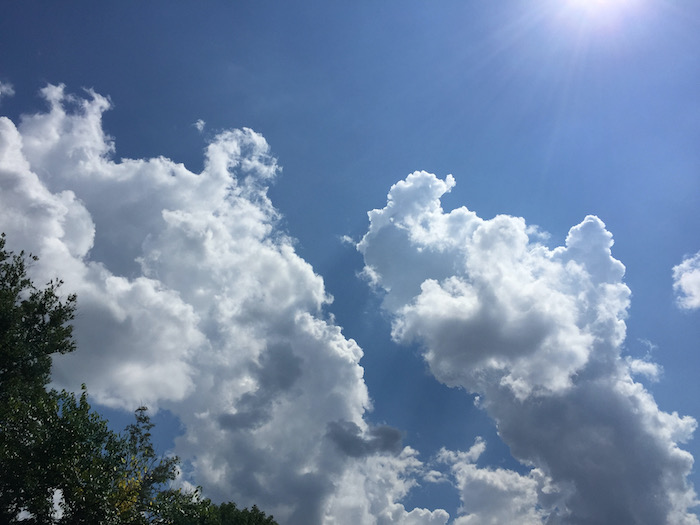






![Bumper sticker reading "I [heart] rien, i'm parisien" (where a heart symbol appears after the word "I."](https://maryhrovat.com/wp-content/uploads/2024/01/bumper-sticker-300x283.jpeg)
















































